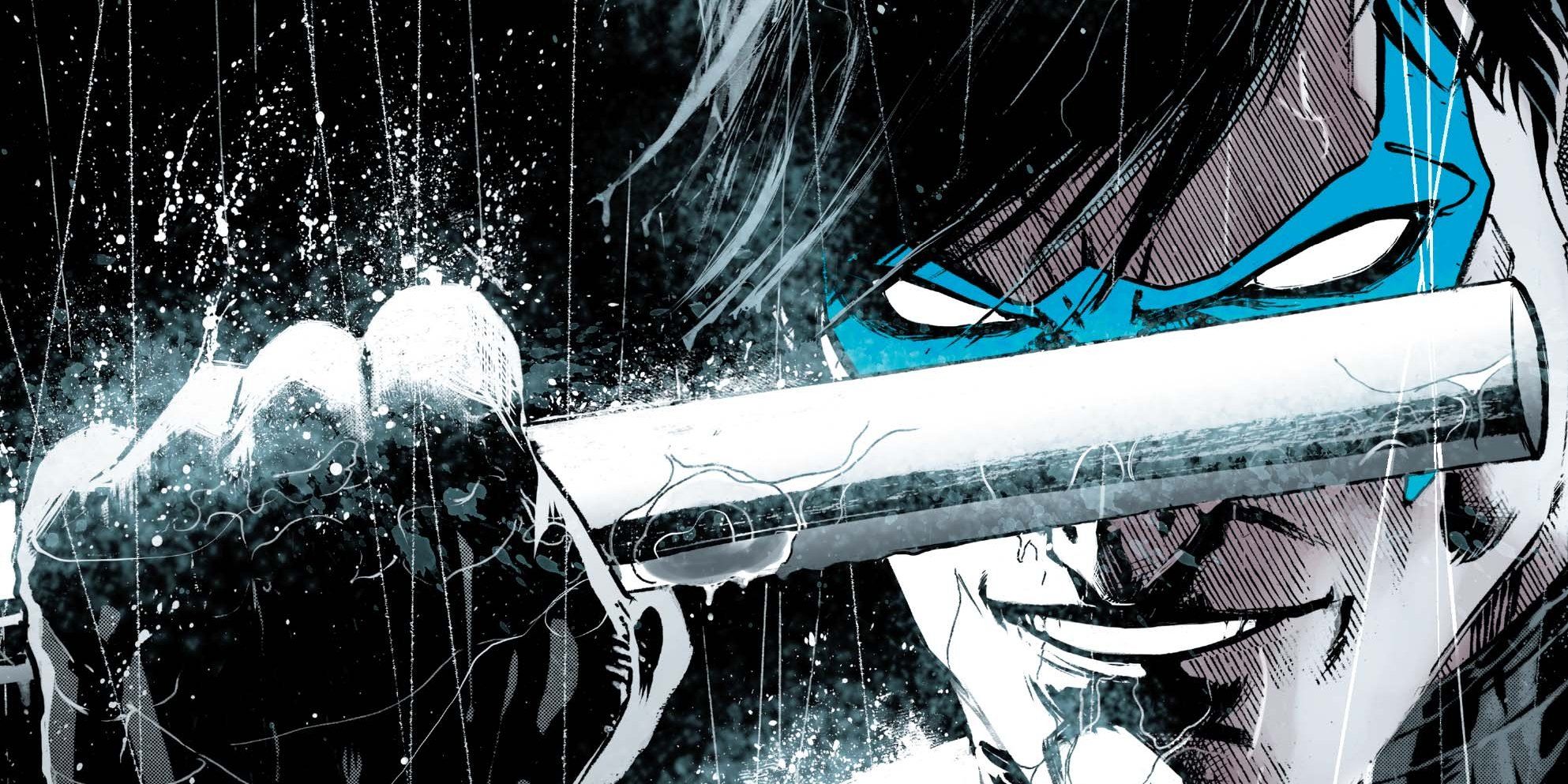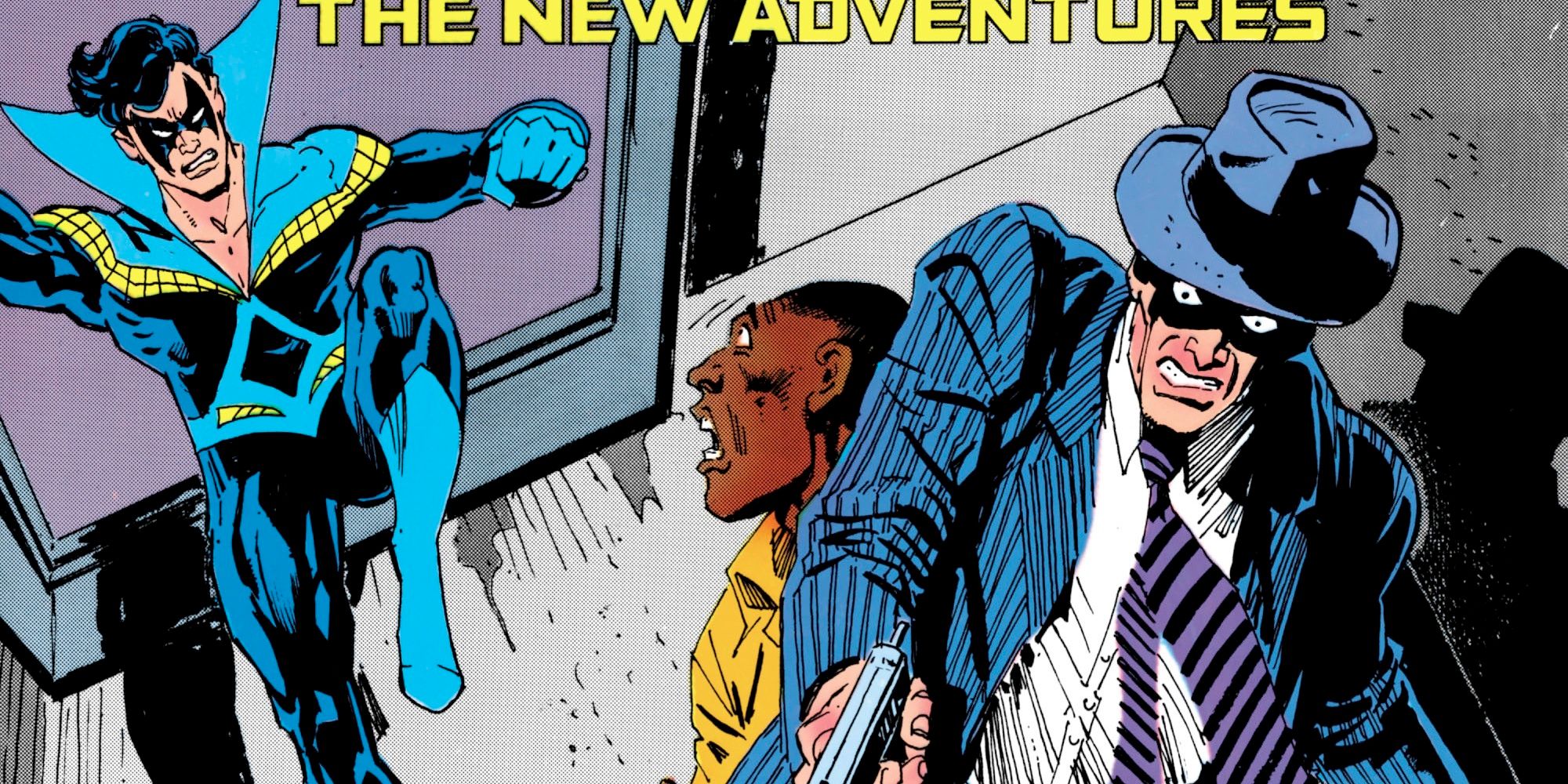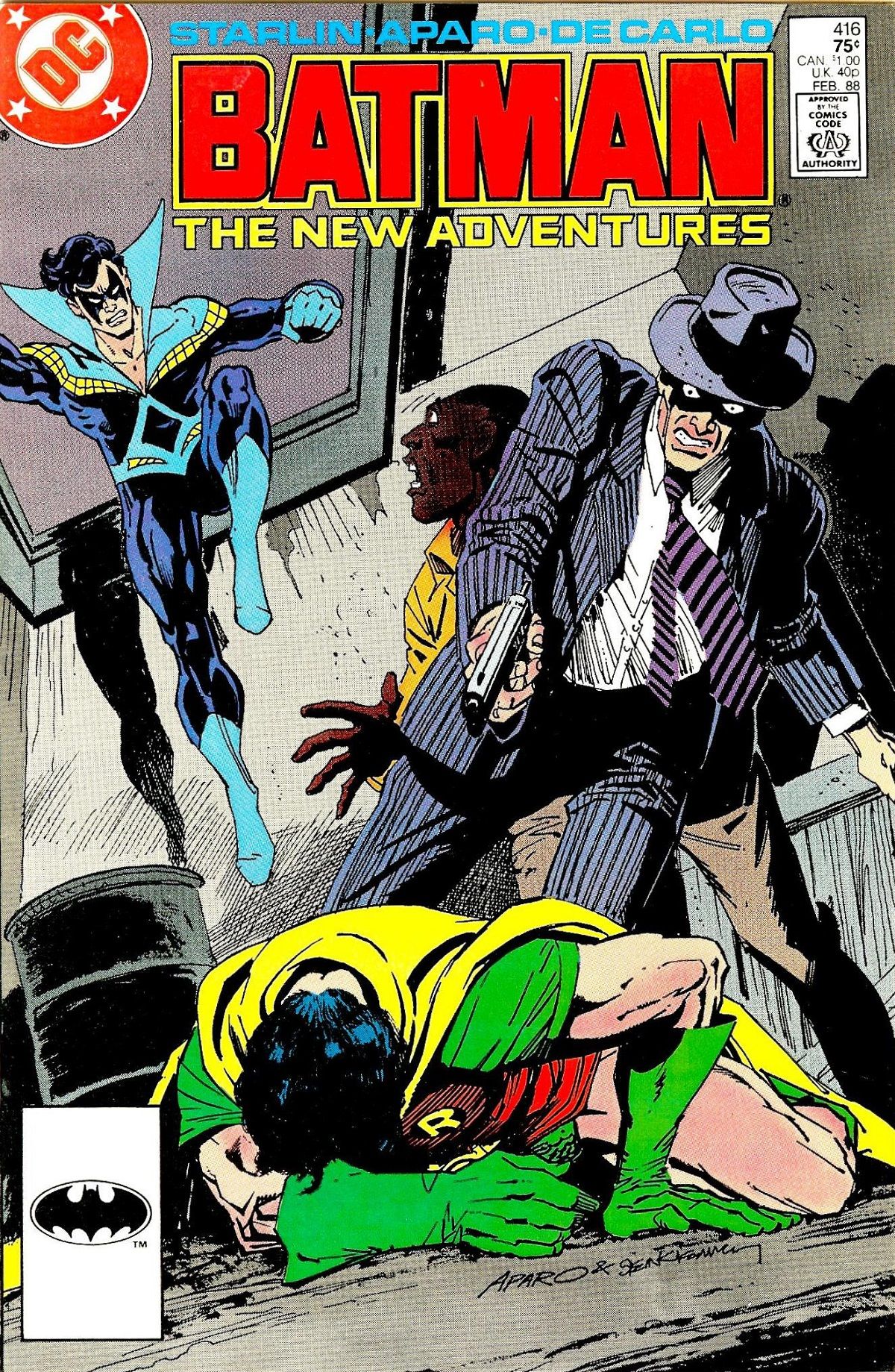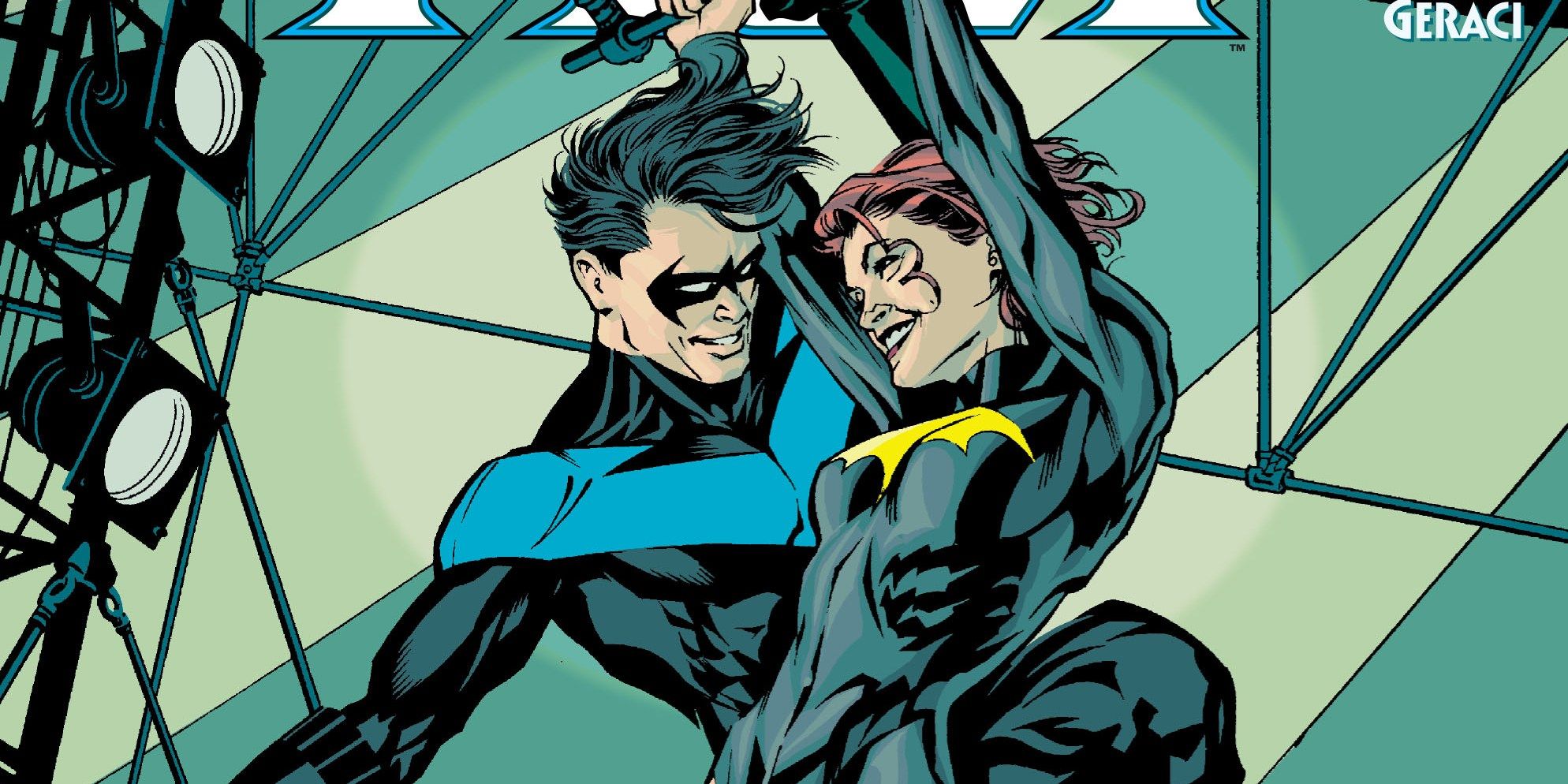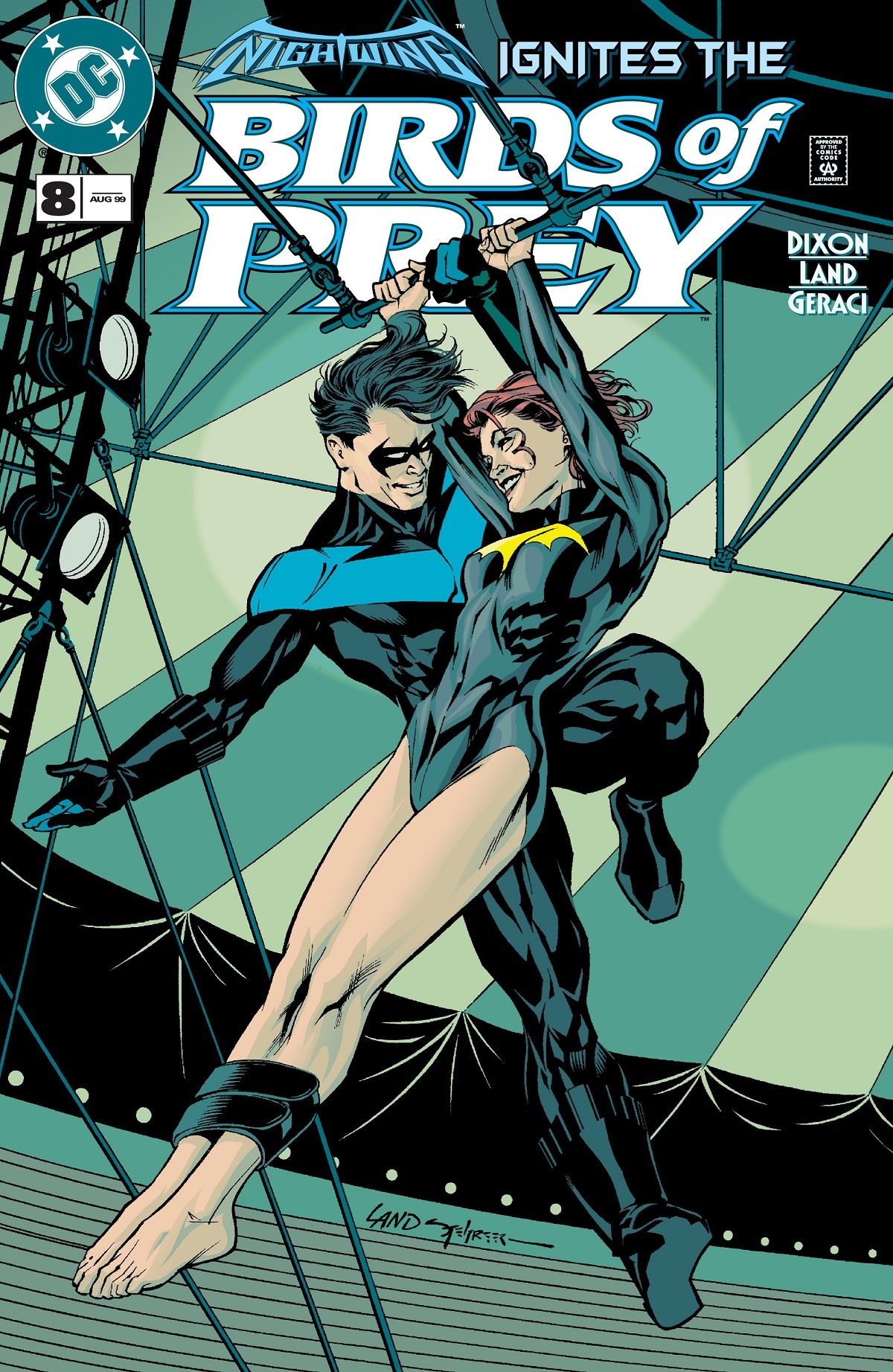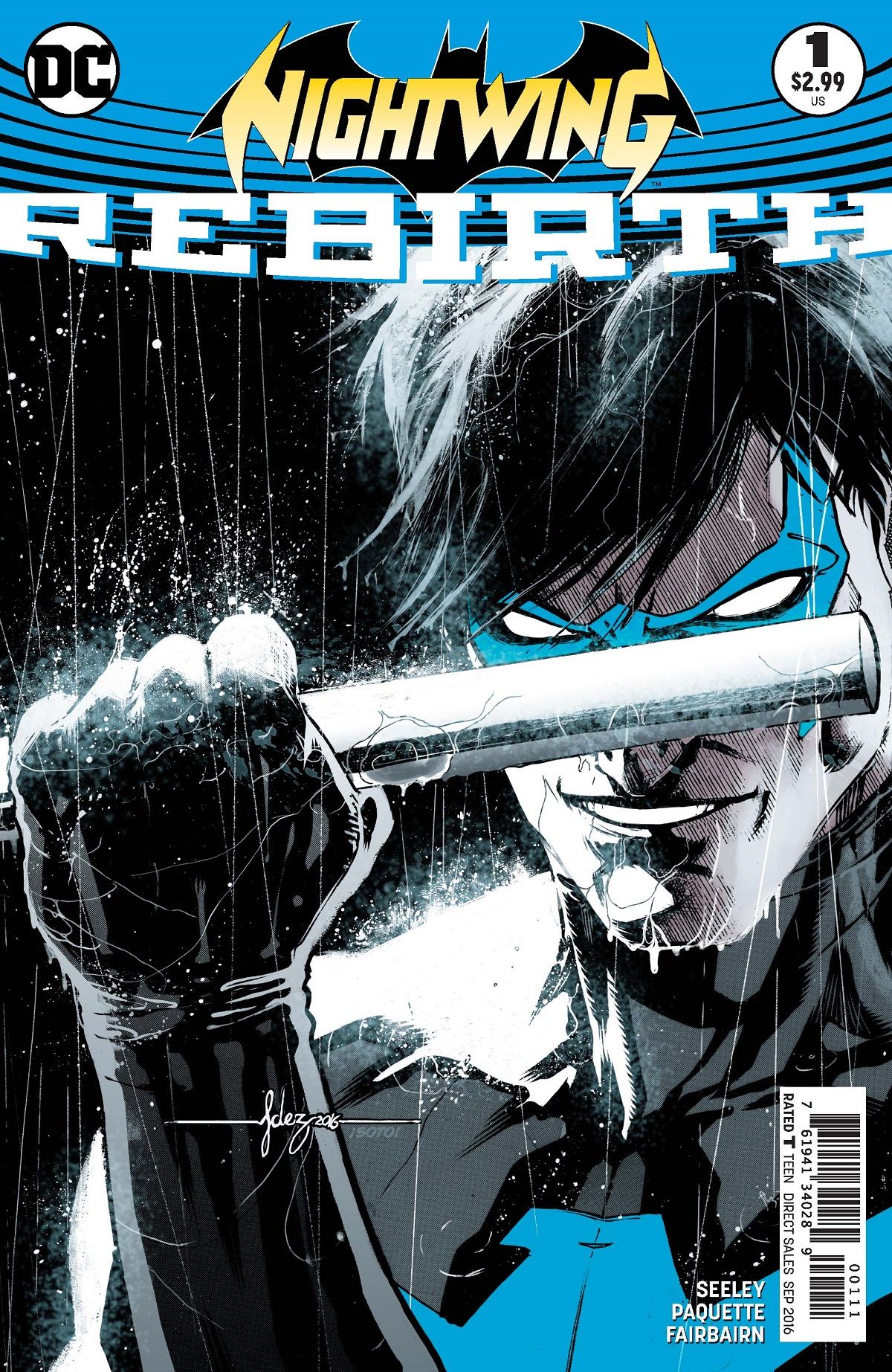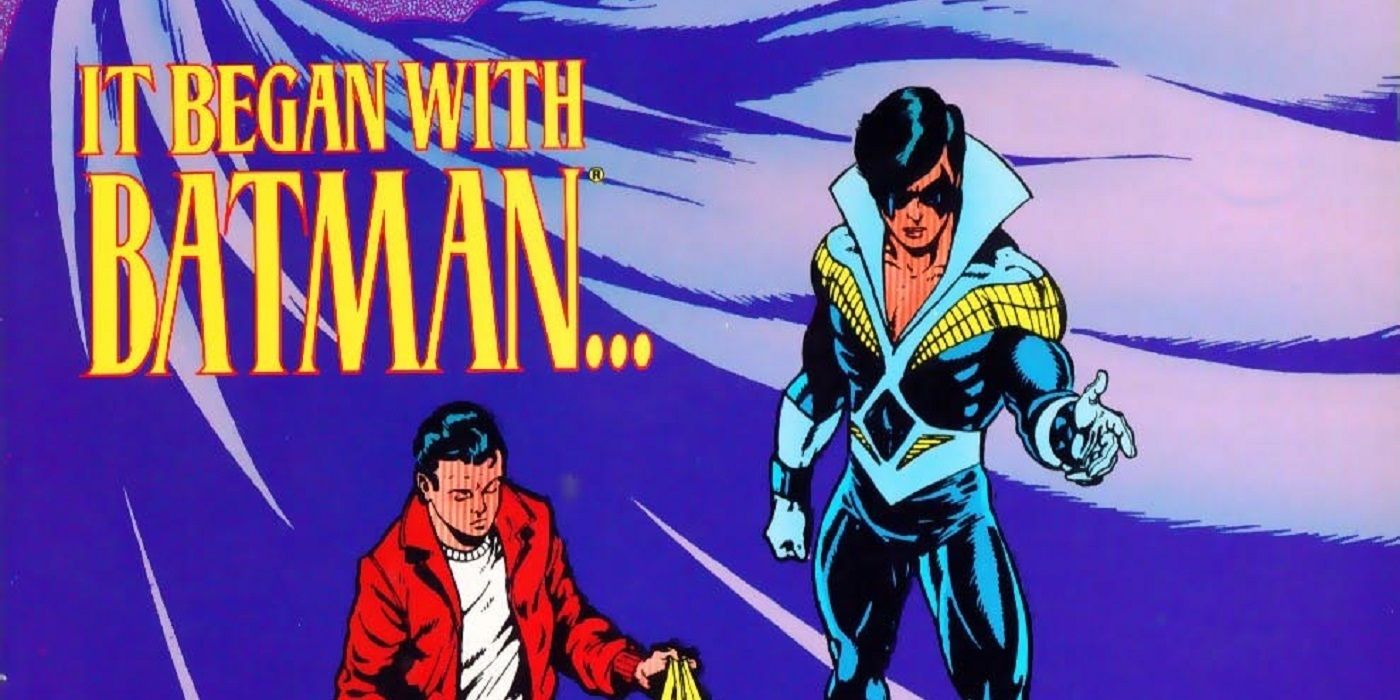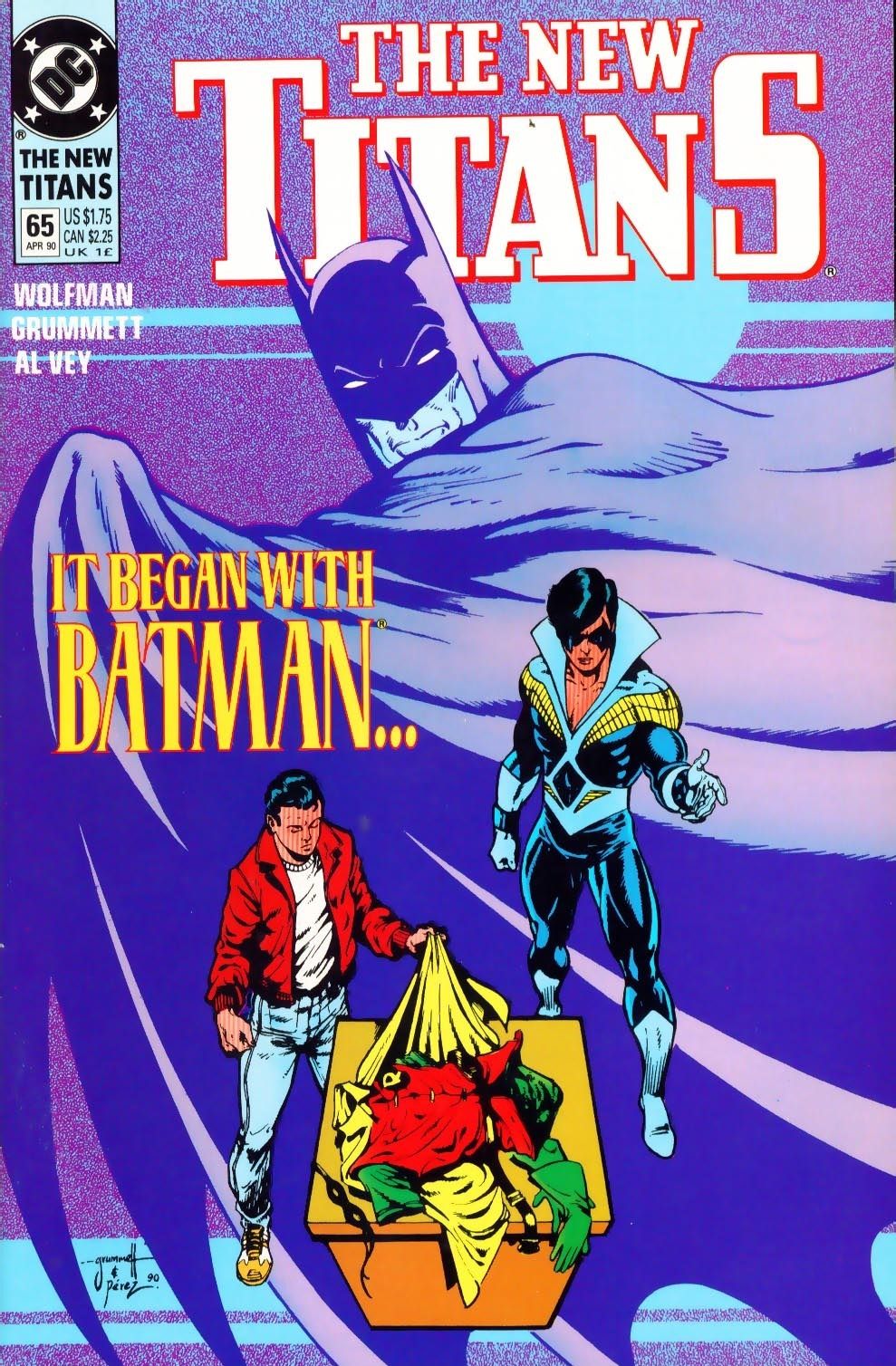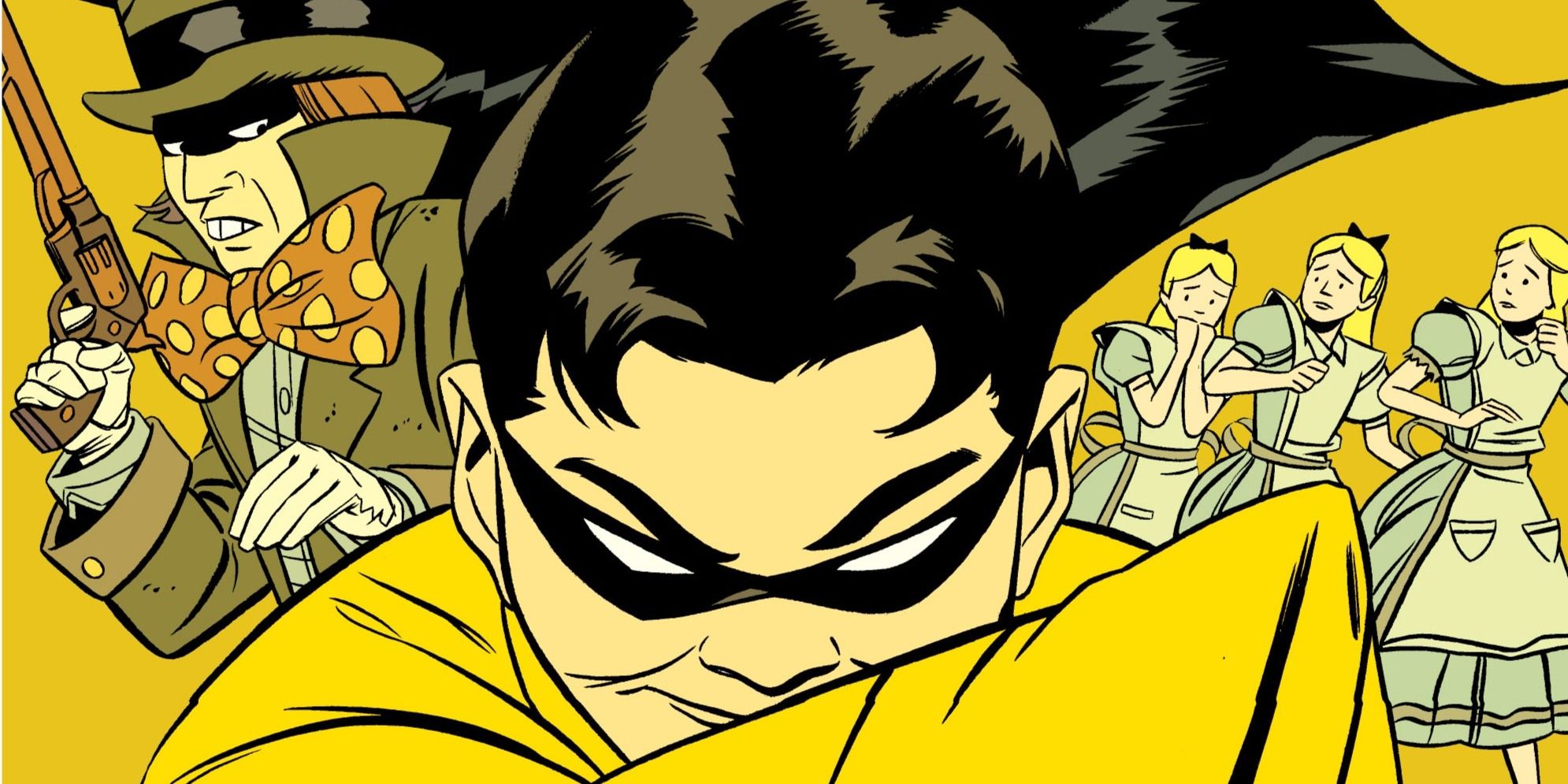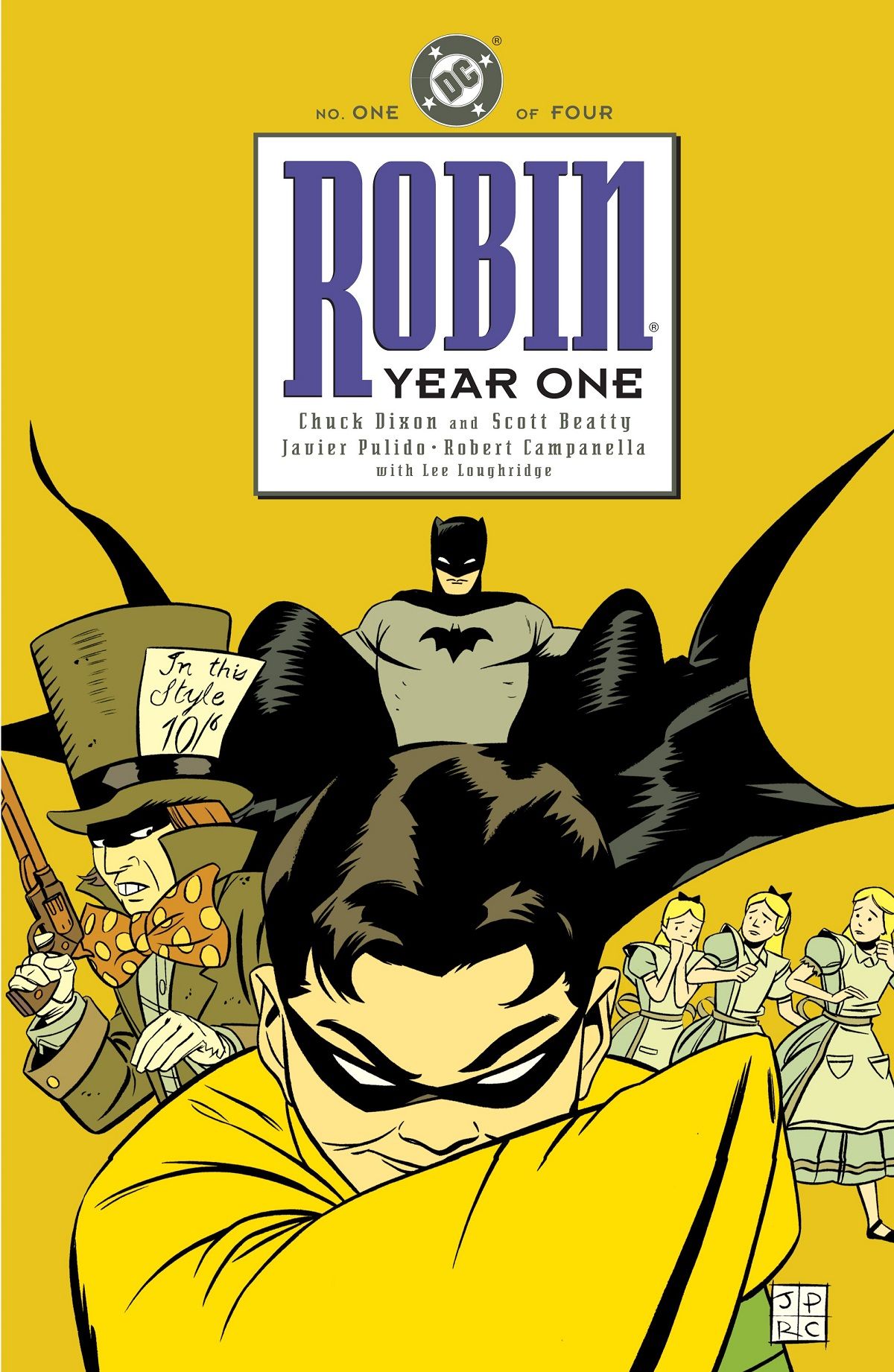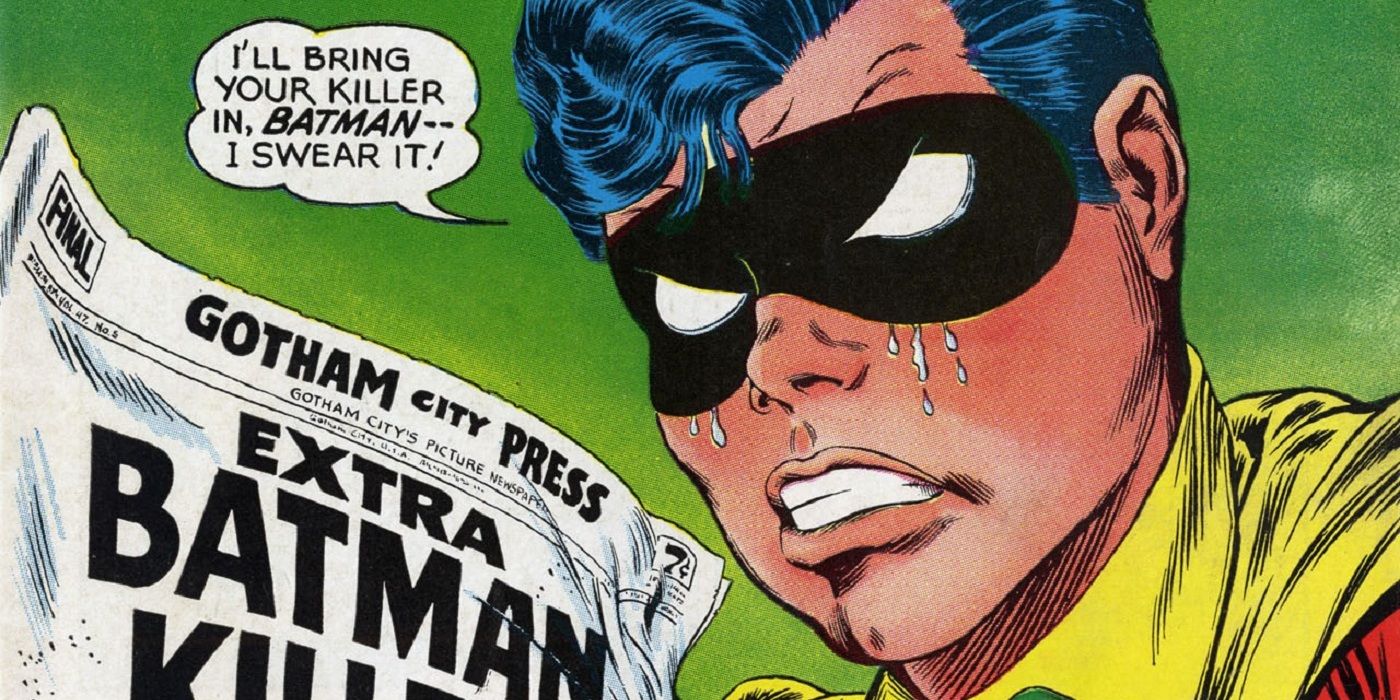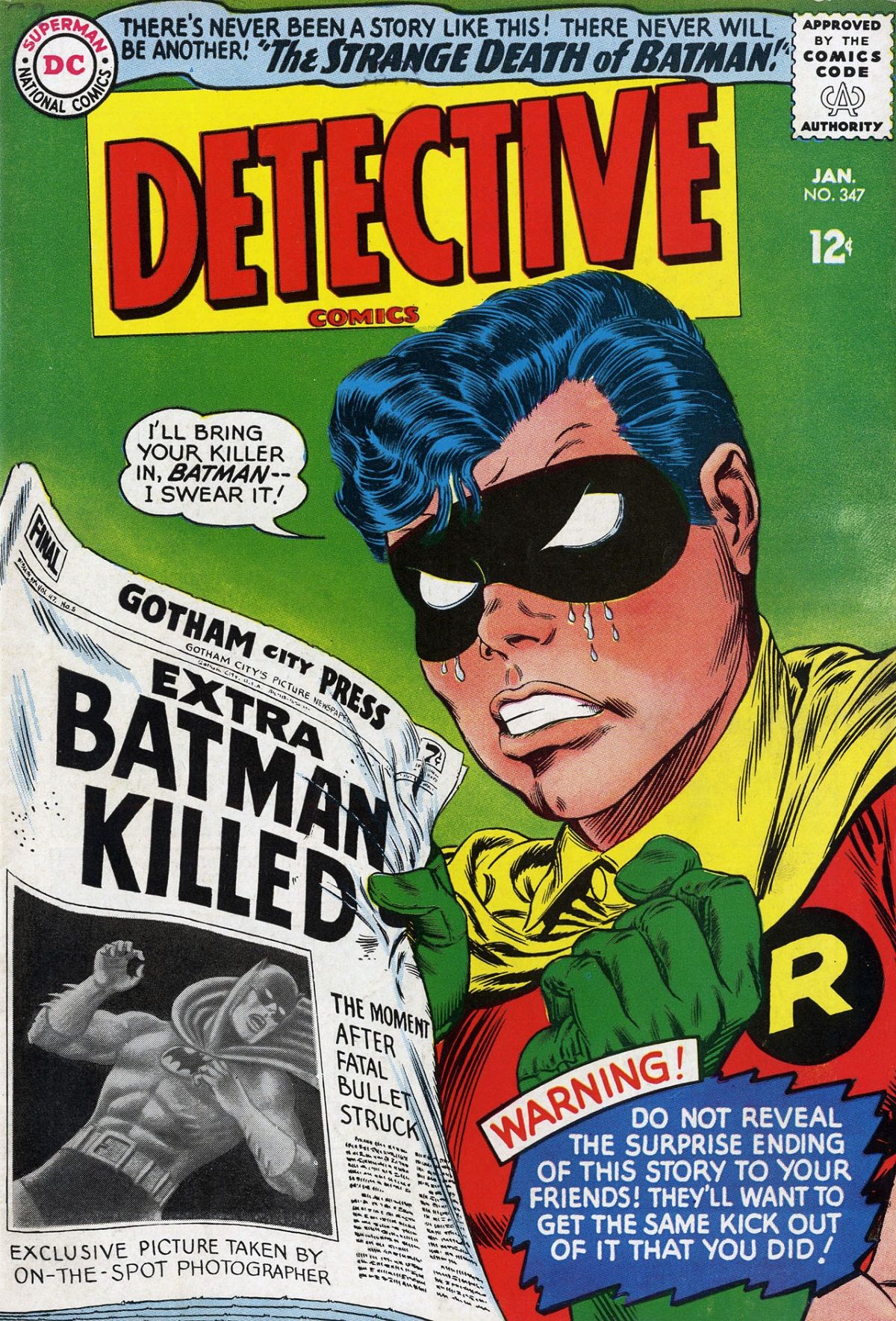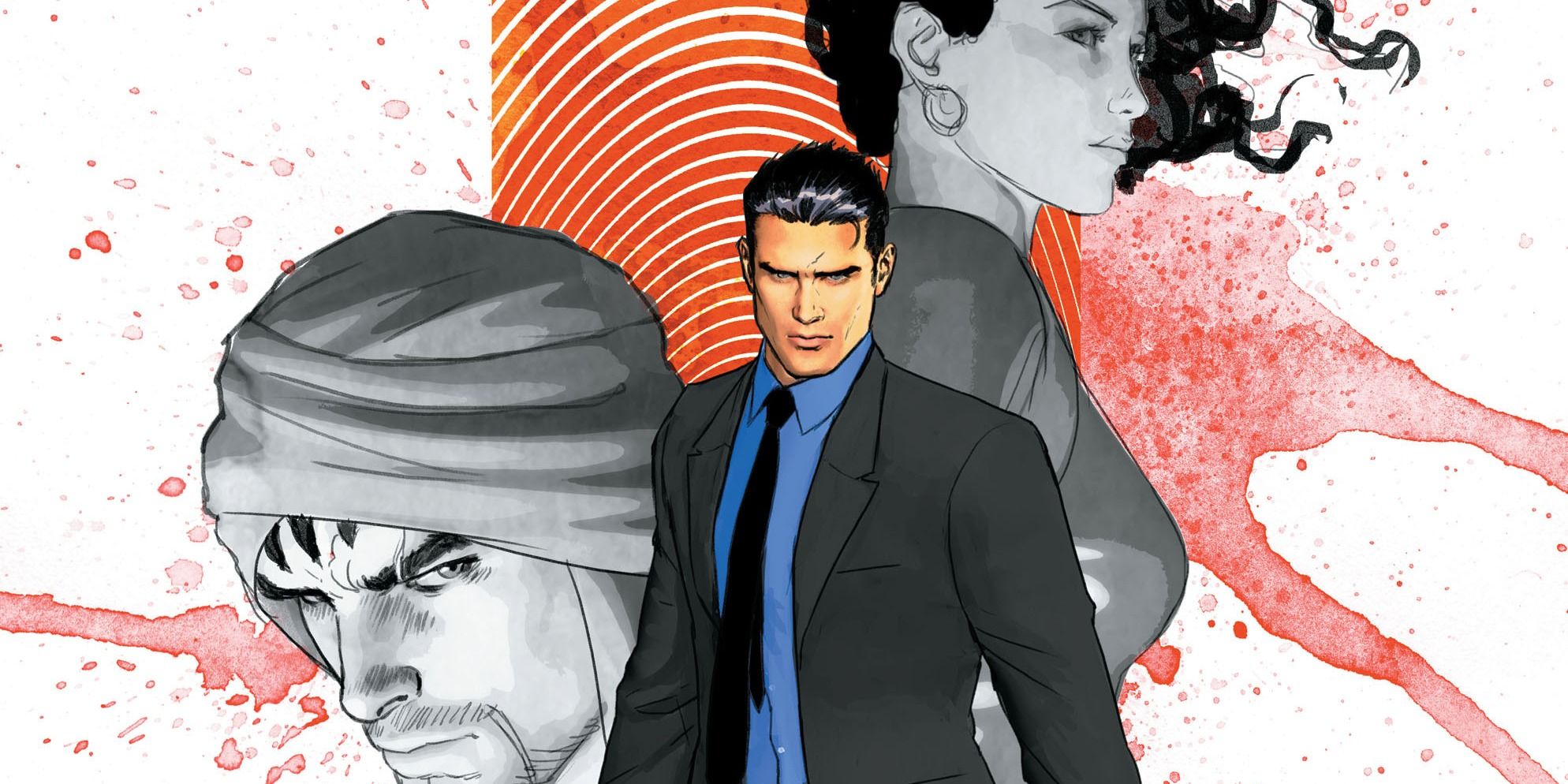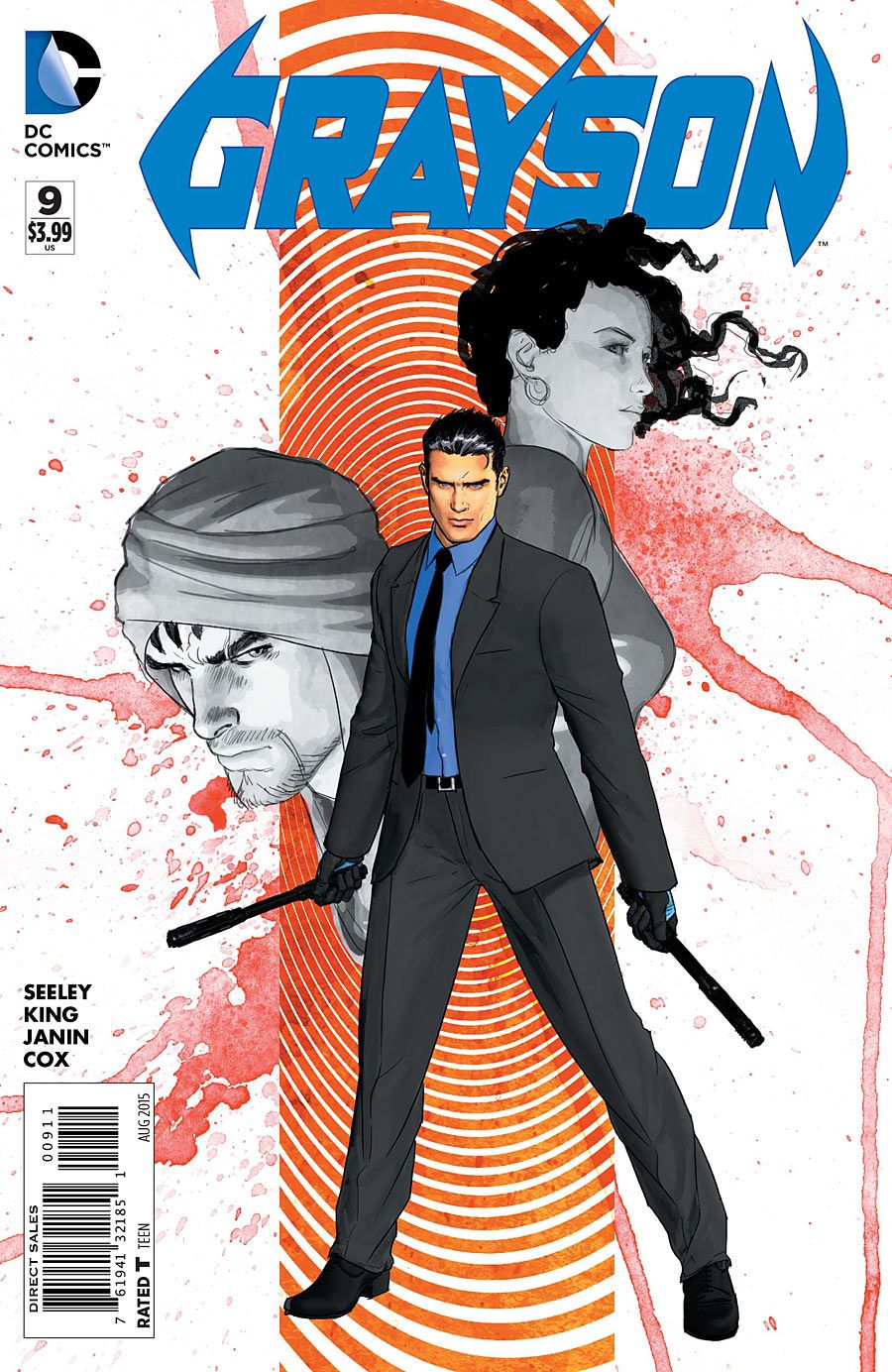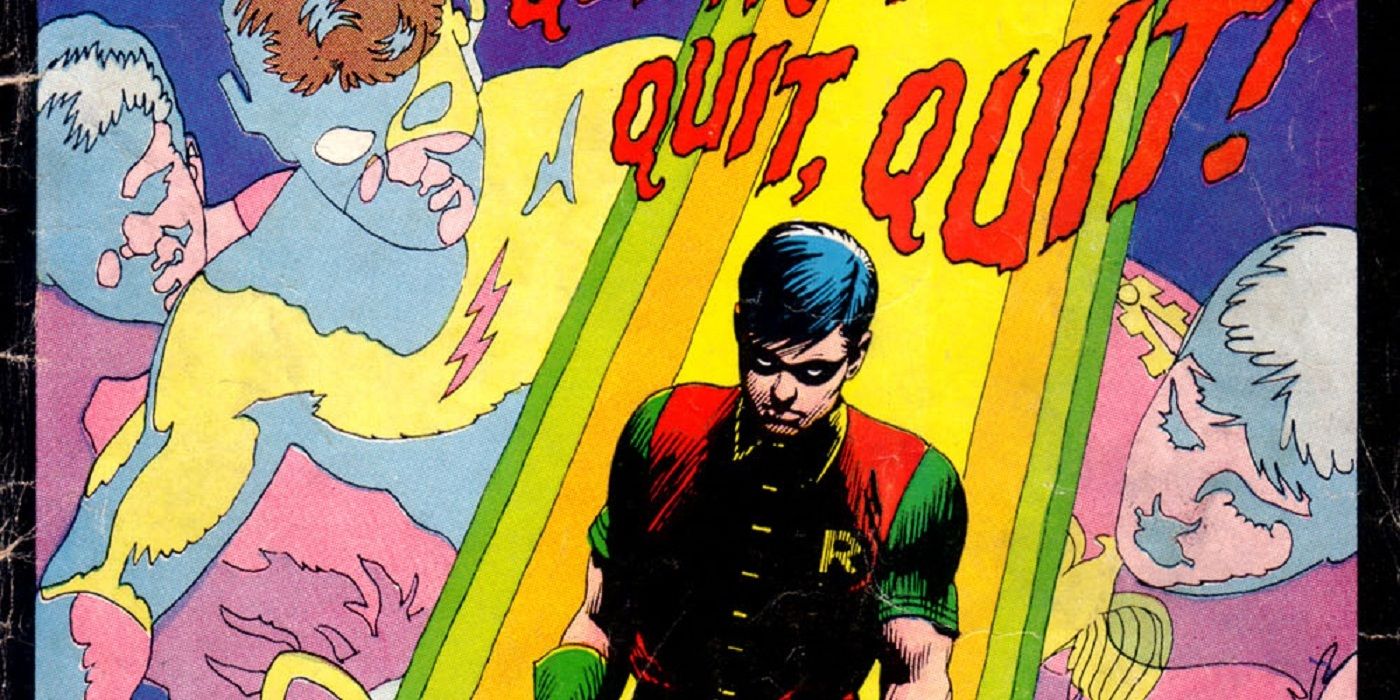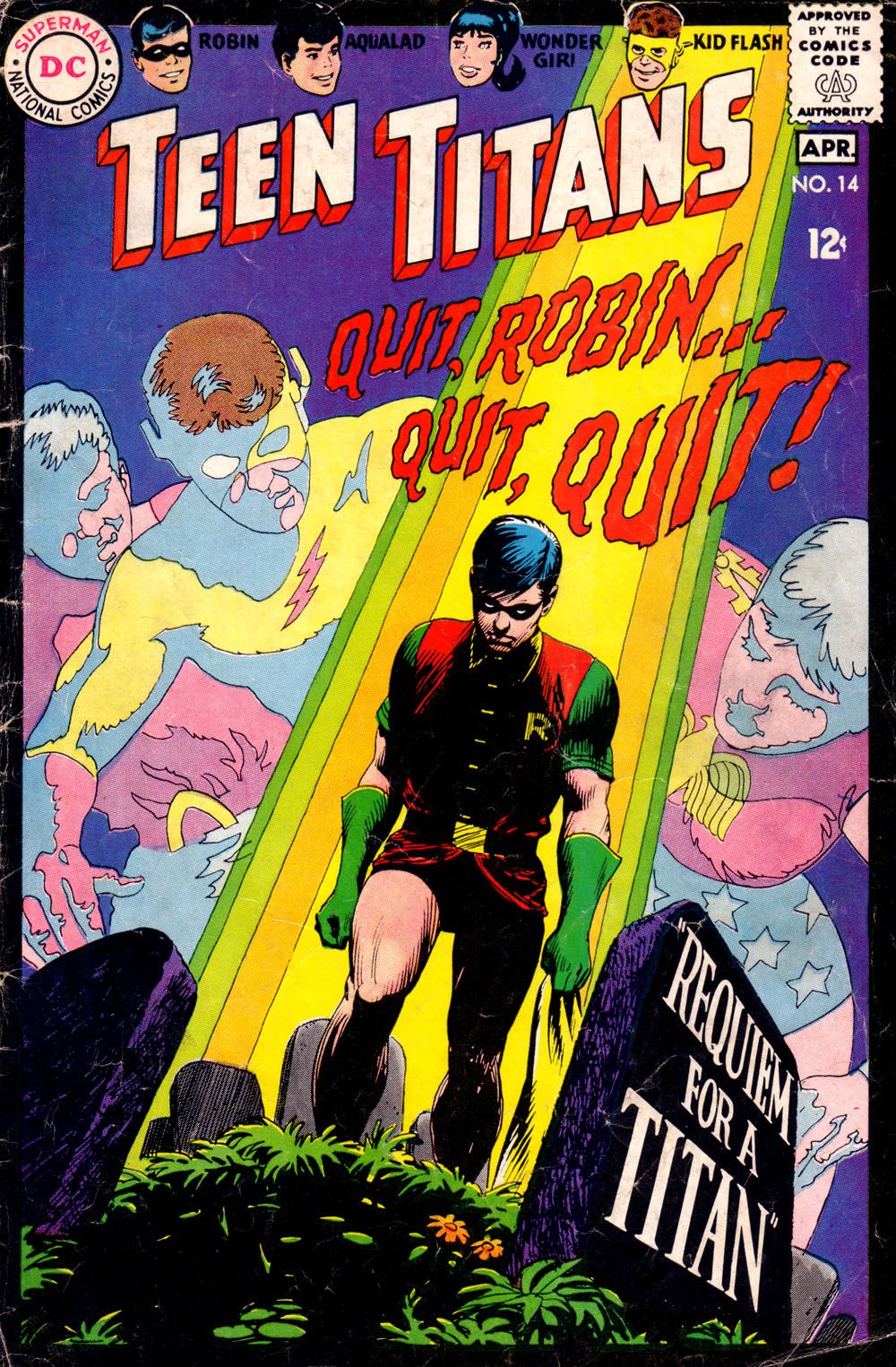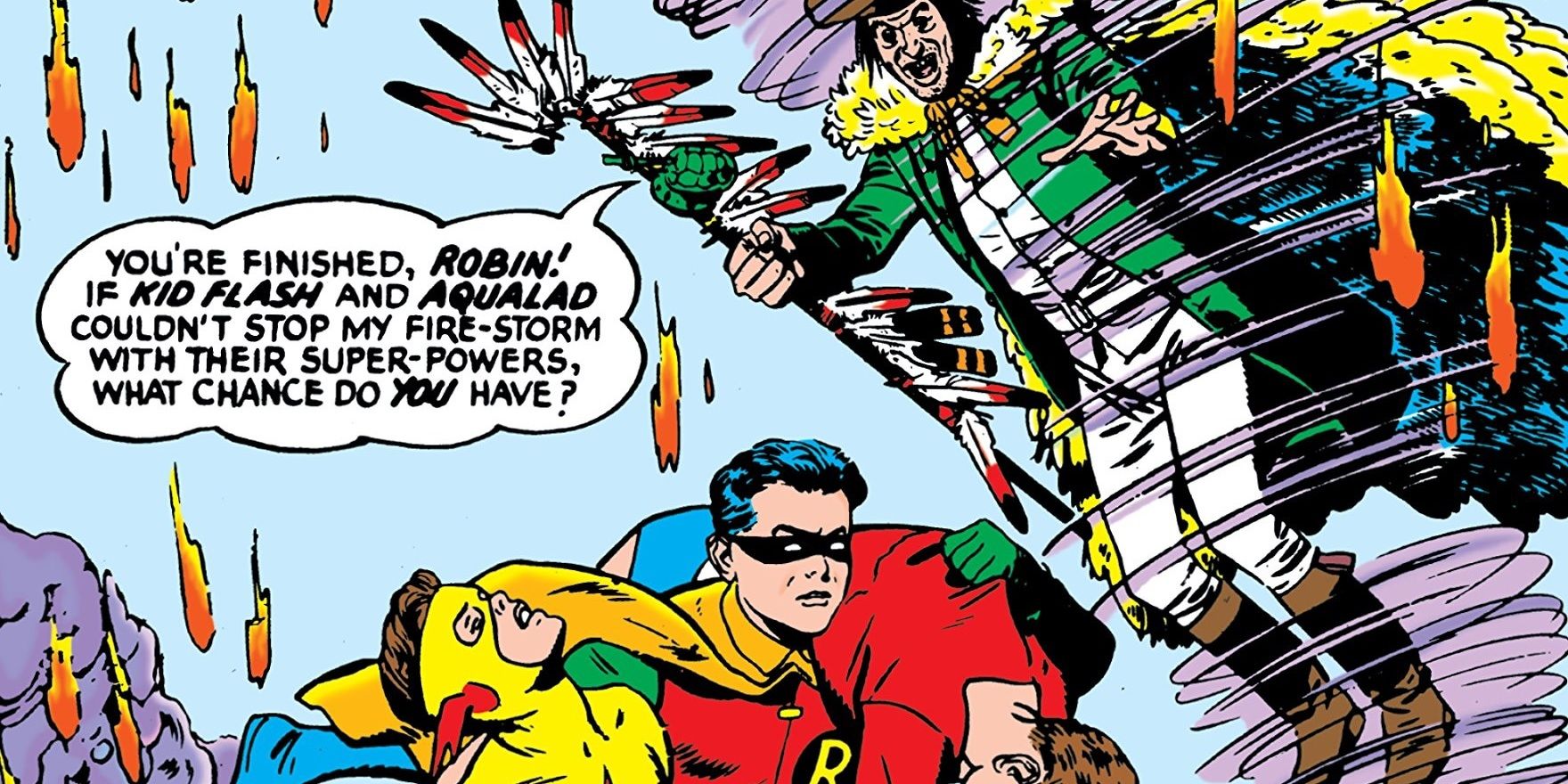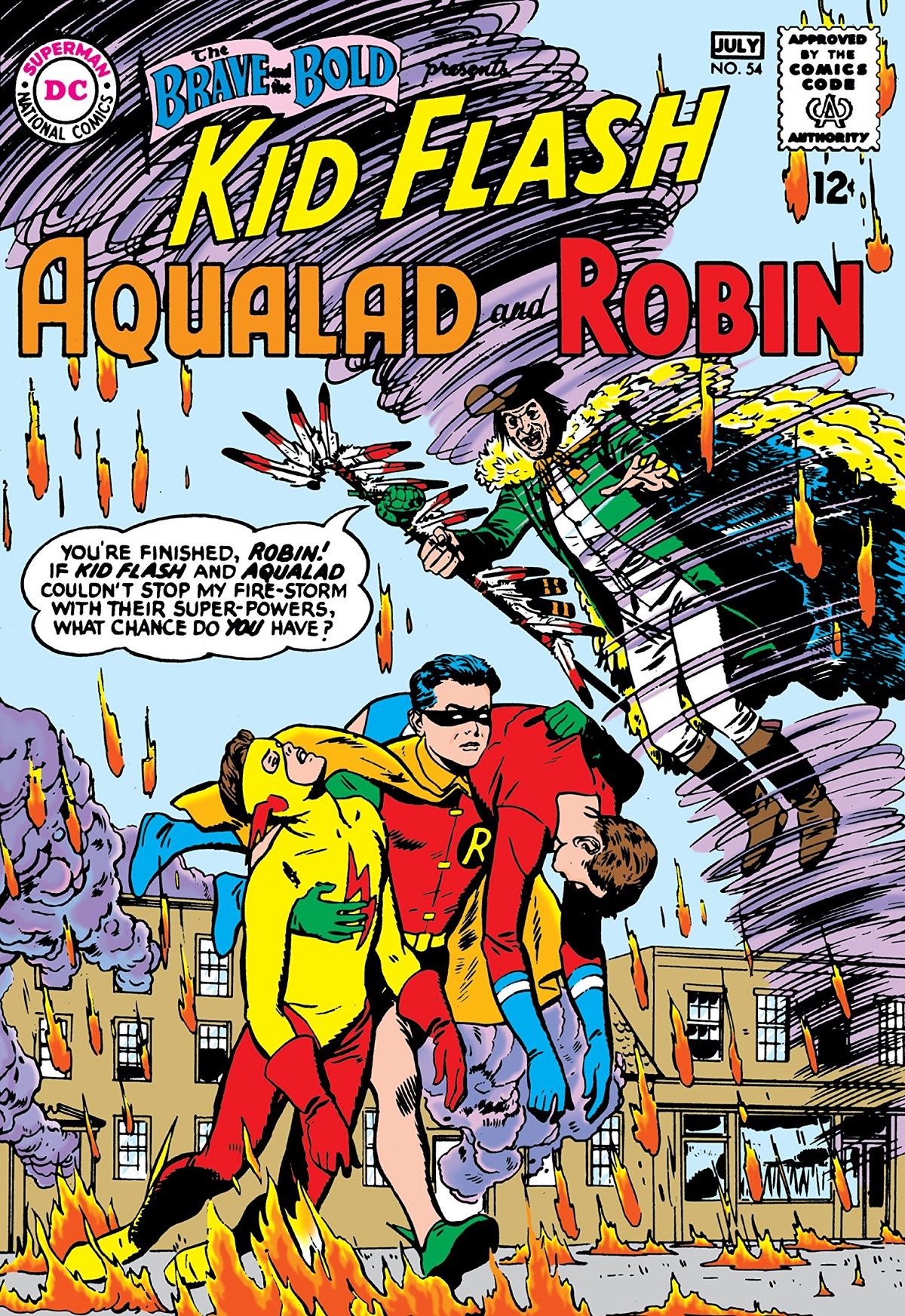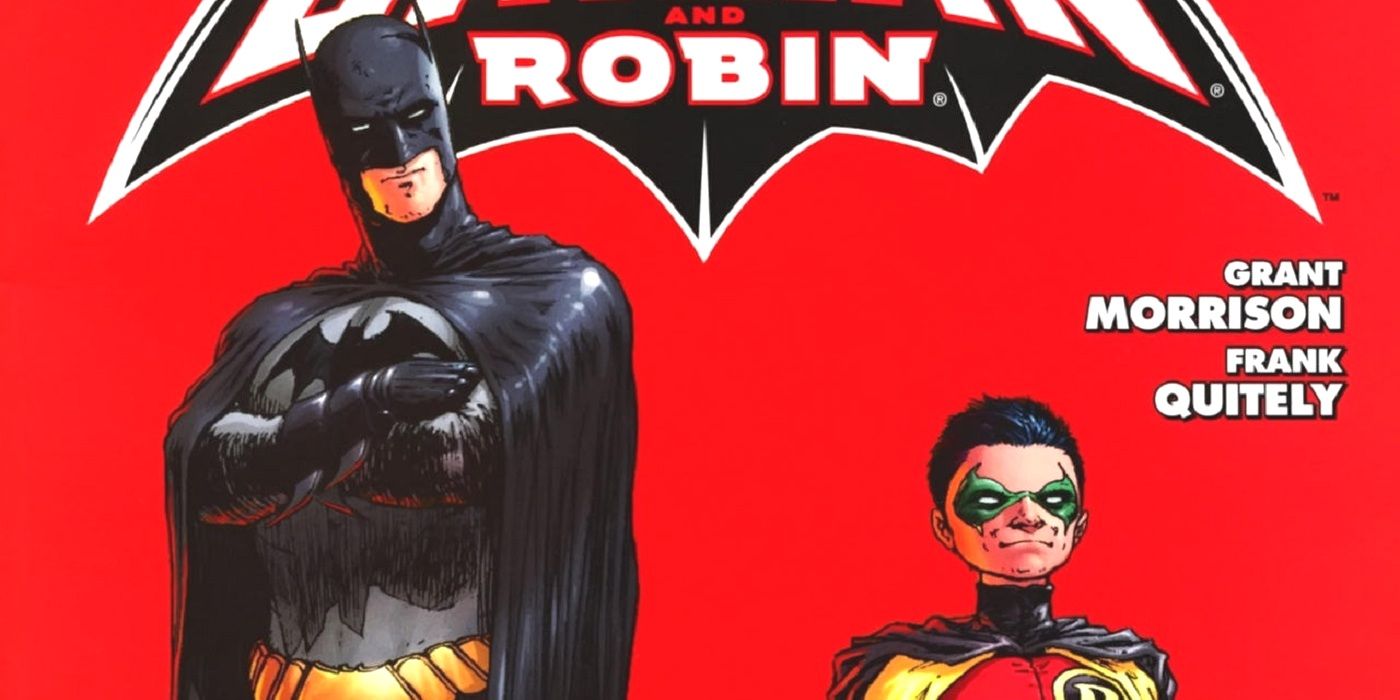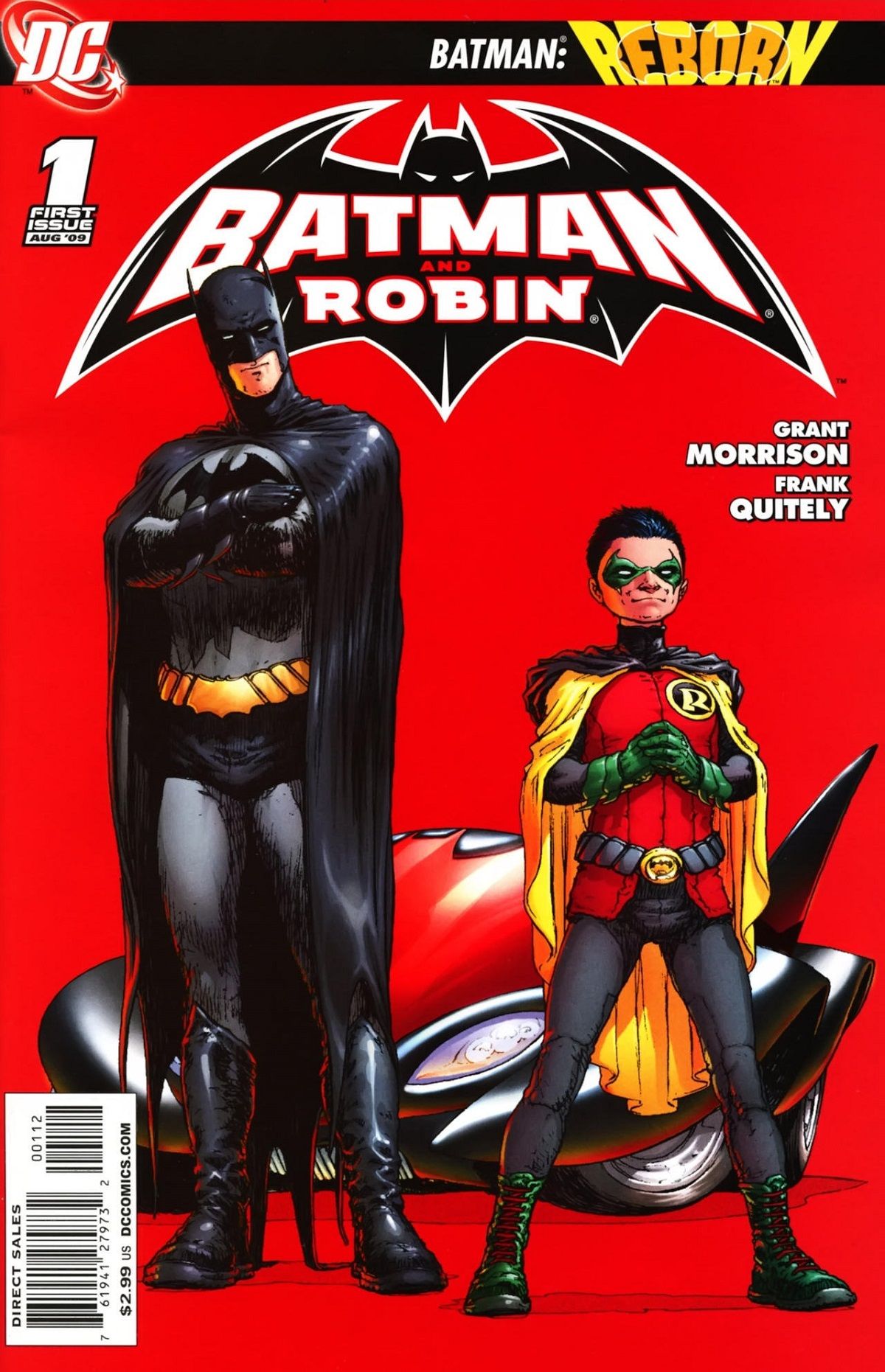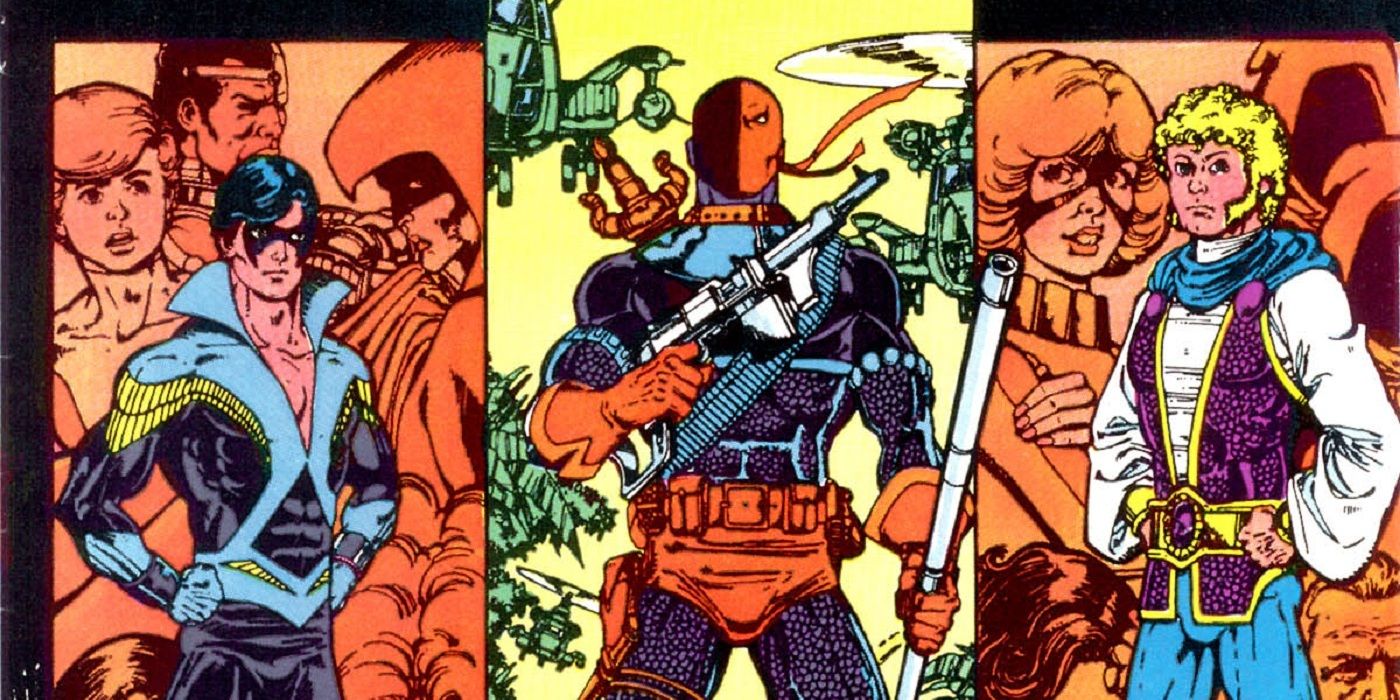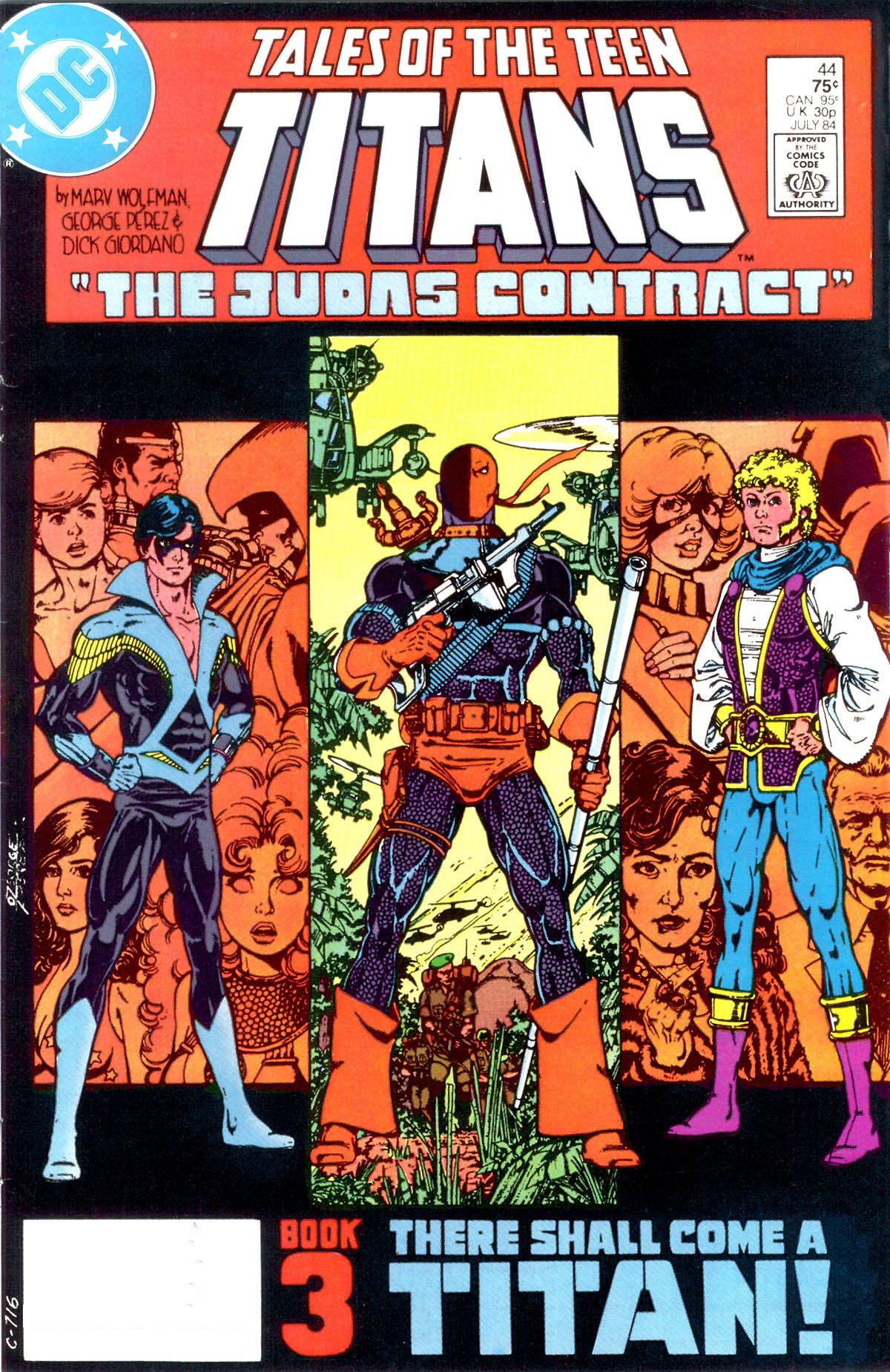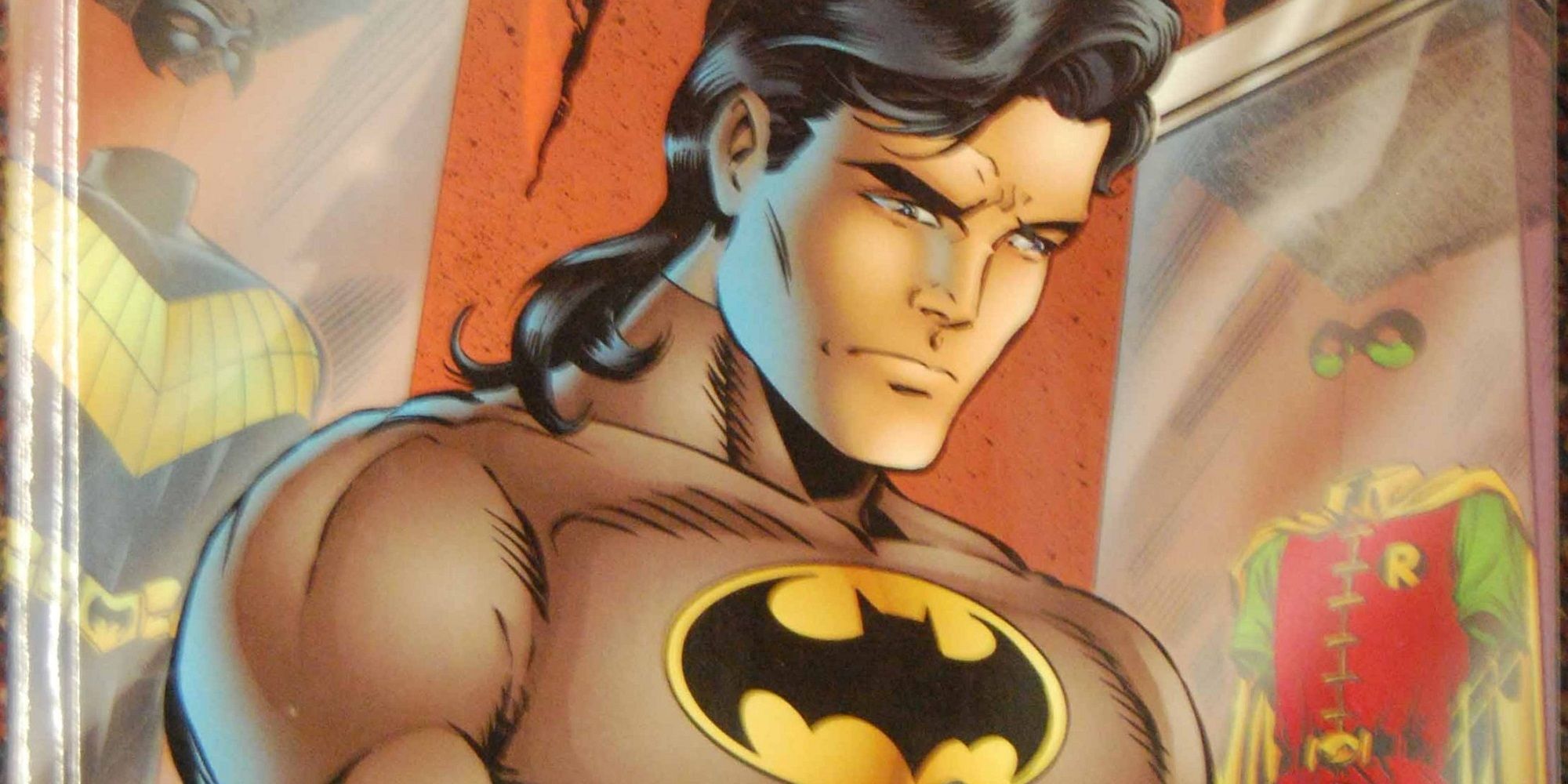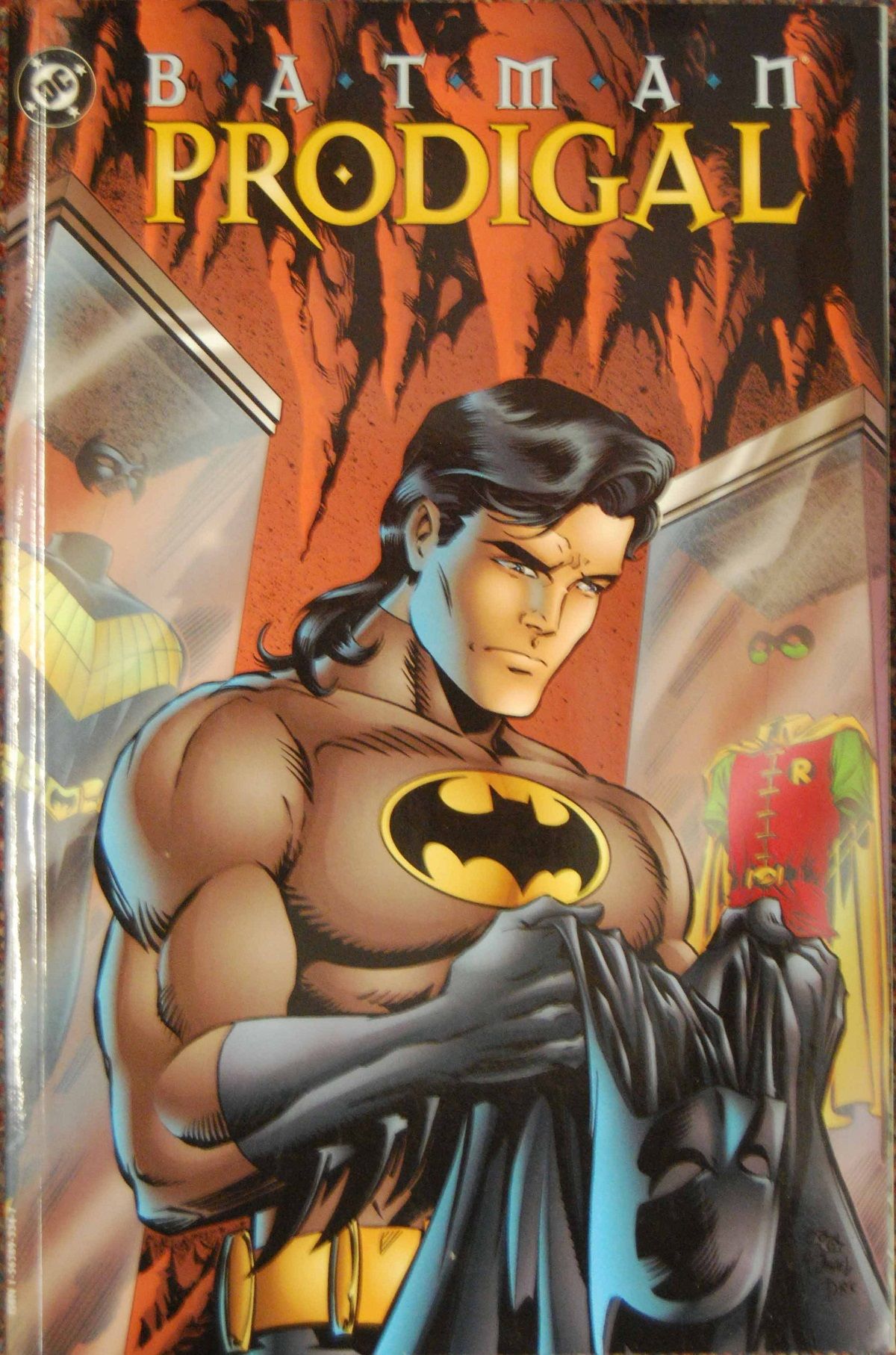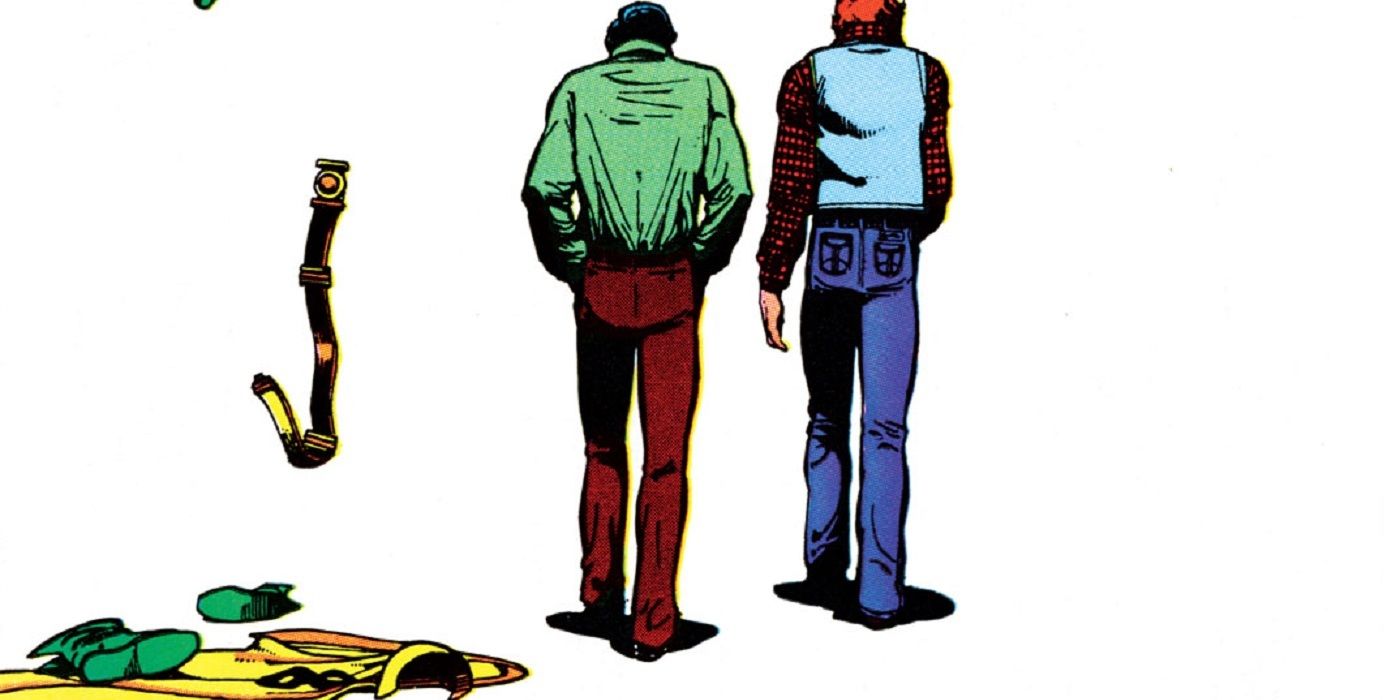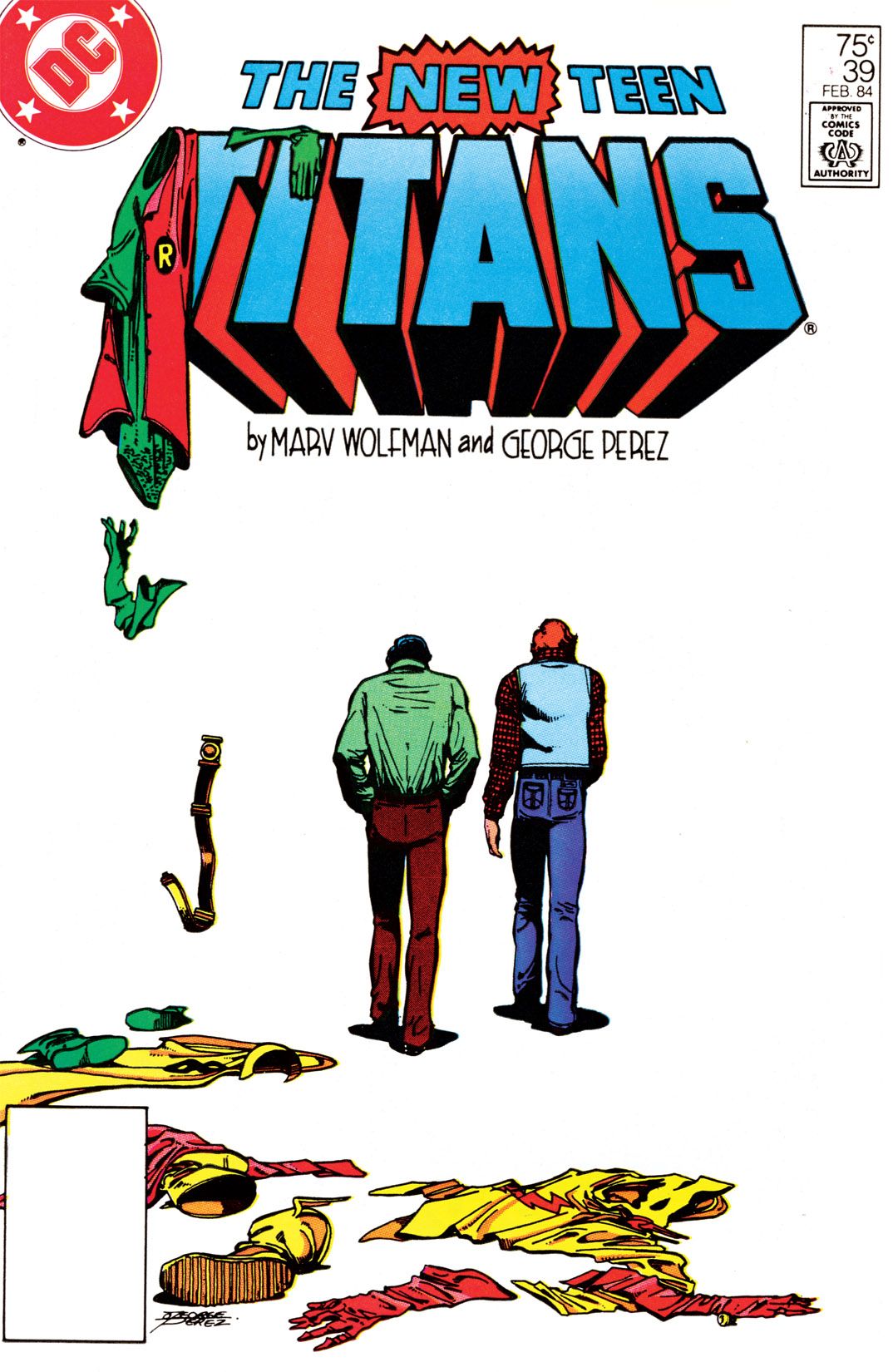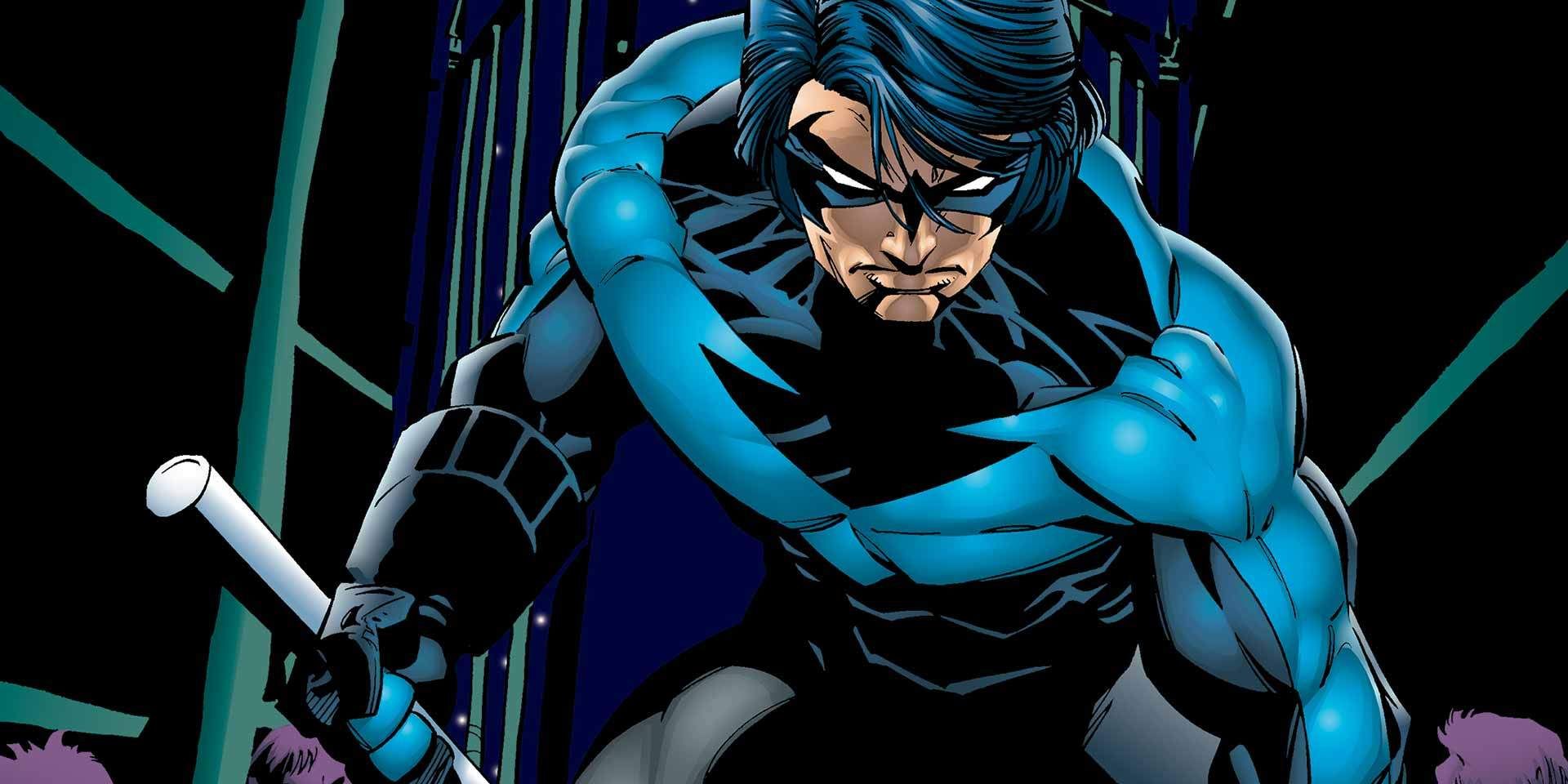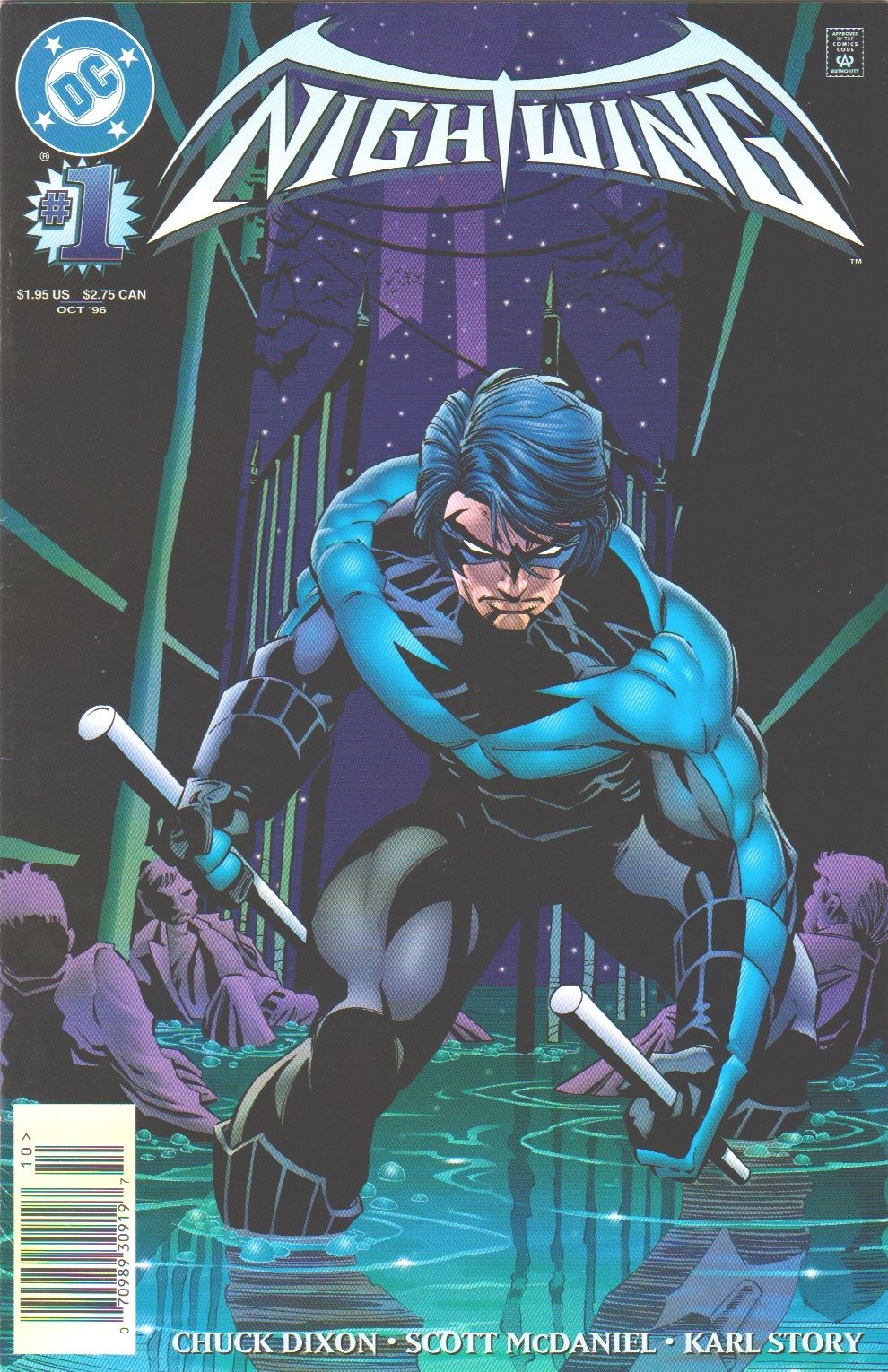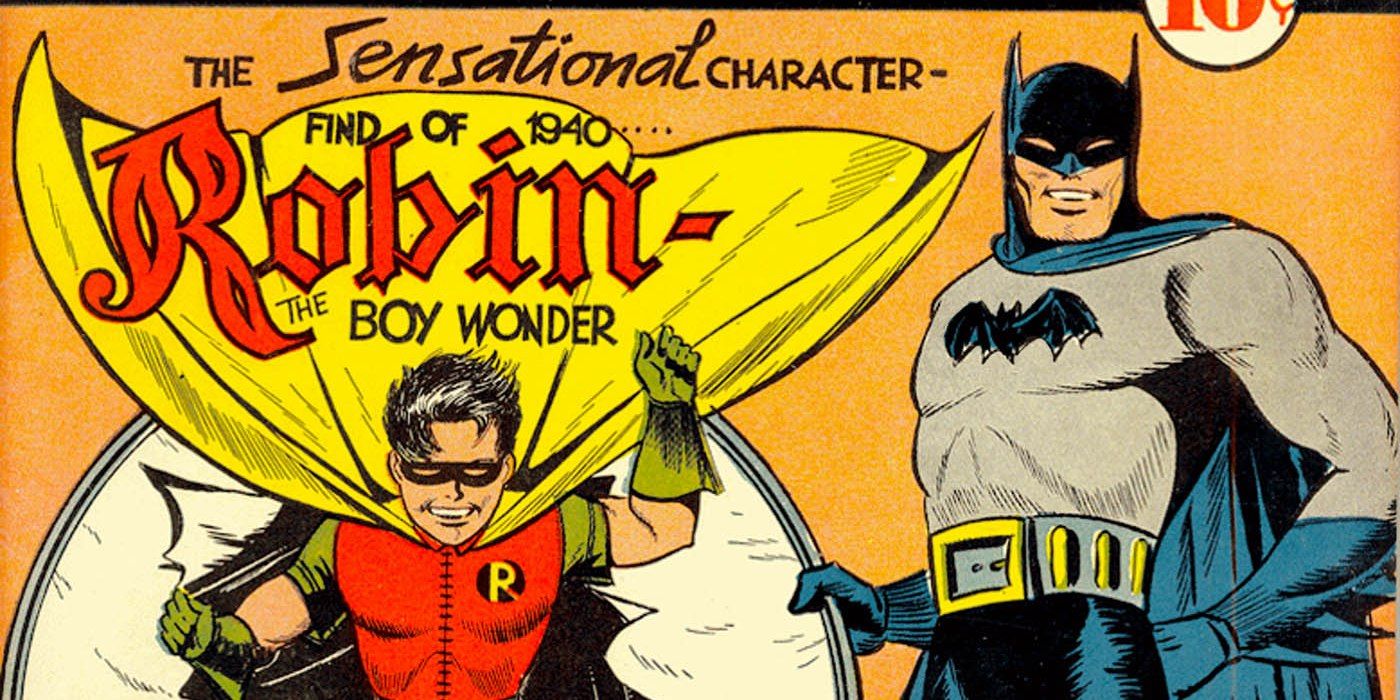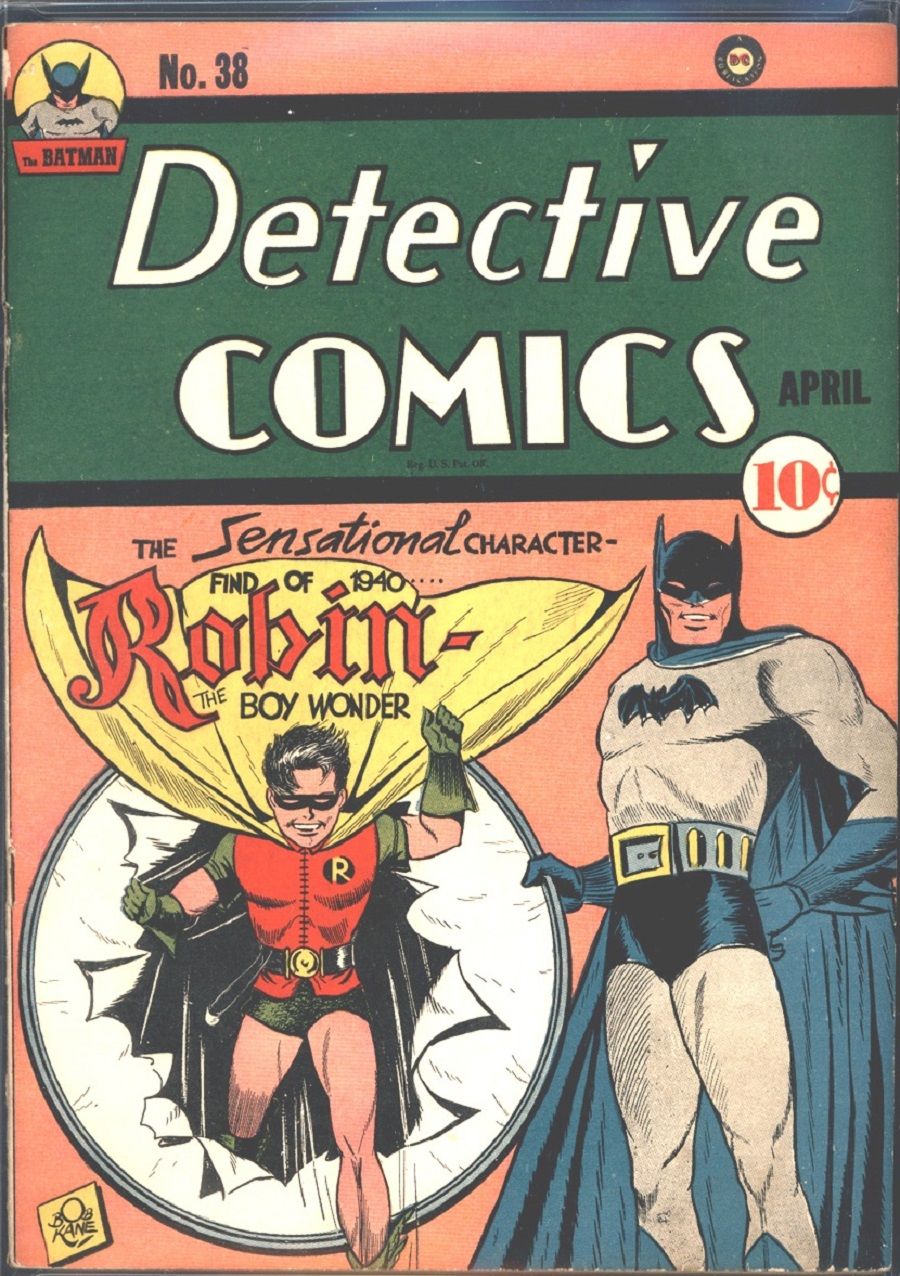Trumpeted as "the sensational character find of 1940," Dick Grayson has lived up to the hype regardless of the decade. Created by Bob Kane, Bill Finger and Jerry Robinson -- and developed further by the likes of Marv Wolfman and George Pérez, Grant Morrison and Frank Quitely, Tim Seeley, Tom King and Mikel Janin -- Dick's grown up slowly but surely before the eyes of countless comics readers. After 44 years as the prototypical superhero sidekick Robin, he struck out on his own as Nightwing before brief stints as Batman and the super-spy codenamed Agent 37.
RELATED: Round Robin: The 15 Best Boy And Girl Wonders
Along the way Dick attracted a loyal and passionate fanbase who went from being "Robin-Rooters" to "Wing-Nuts." (We're not sure about the Agent 37-specific term). More than just a "nice" Batman, Dick is a popular trailblazer in his own right. With rumors swirling about a Nightwing movie, here are 15 of Dick's most iconic covers.
15 BATMAN #416
Pencilled by Jim Aparo and inked by Bill Sienkiewicz, this cover accompanies February 1988's "Batman" #416, an issue pairing Nightwing with his successor, Jason "Robin" Todd. Such team-ups were rare in those days, because as a member of the New Titans Nightwing was under editor Barbara Randall, while Robin was controlled by Bat-editor Denny O'Neil. Indeed, a big reason for Jason's introduction as Robin was to get Dick away from the Bat-office and closer to the Titans.
Additionally, Jason's newly-revised origin was designed to separate him further from Dick, so this issue -- wherein Dick helps Jason with a drug bust, the two bond over their mutual mentor, and Dick and Bruce reconcile somewhat -- bridged some continuity gaps in both Robins' backstories. While those behind-the-scenes tidbits would have made this cover noteworthy at the time, it stands alone pretty well. Regular Bat-artist Jim Aparo didn't get to draw Nightwing a lot, and rendering the "disco-collar" costume was tricky enough. Even so, Aparo plays with expectations by fitting Nightwing a convincing substitute into a classic Batman situation.
14 BIRDS OF PREY #8
The cover of August 1999's "Birds Of Prey" vol. 1 #8 finds penciller Greg Land and inker Brian Stelfreeze depicting a great moment between Nightwing and Oracle. Him helping with her acrobatic physical therapy brings together his childhood in the circus and her past as Batgirl. It works for shippers and non-shippers alike, because the expressions and poses are platonic. These are two old friends are used to relying upon each other, and the reader can choose whether there's something more behind their smiles.
Land depicts Oracle as arguably more vulnerable here, since she's out of her wheelchair and dressed only in a bat-emblazoned leotard. However, one might also view this cover as showing Oracle's tremendous resolve, "flying" with Nightwing regardless of her body's capabilities. In fact, it looks like Oracle is doing most of the work. This cover shows Nightwing once more in an instructional-slash-support role, a position he's occupied in one way or another ever since the early Teen Titans days. Layering that into his deep, complex relationship with Barbara Gordon makes for an especially rewarding image.
13 NIGHTWING: REBIRTH #1
After a few years with red highlights and a couple of years out of costume, Dick Grayson is back in blue on Javier Fernandez and Chris Sotomayor's cover of September 2016's "Nightwing: Rebirth" special. The rainswept, lightning-streaked closeup of a grinning Nightwing and his escrima stick tells readers all they need to know about Dick Grayson's return to superheroics. The mask signifies the end of his non-secret identity; the costume shows he's left the spy game behind; the blue on the costume is a more direct nod to longtime fans who maybe didn't like the New 52's red; the bad weather sets a quintessentially Gotham-style mood; and the big smile reassures readers that it's going to be fun.
Moreover, the closeup isn't just Nightwing "in your face," but invites a more personal connection between reader and character. The variant cover was a full-figure shot of Nightwing looking back over his shoulder at the reader, and while that did offer a good shot of Dick's backside -- which is important for many people, we know -- it also made him appear more aloof. Instead, this cover says that Nightwing is good to his friends and dangerous to his foes.
12 NEW TITANS #65
Another Dick-as-mentor moment features Nightwing preparing to train the newest Robin, Tim Drake, on Tom Grummett and George Pérez's cover for April 1990's "New Titans" #65. Writer Marv Wolfman had been on "Batman" in 1980 when "New Teen Titans" launched, and he and Pérez had worked on the "Lonely Place Of Dying" crossover, which introduced Tim. They had already delved into Dick's reaction to Jason's death, so Dick's tutelage of Tim helped move along some subplots.
The cover itself isn't overly complex, with Batman's influence informing both Nightwing and the out-of-costume Tim. Naturally, their attention (and ours) is focused on the classic Robin outfit, which Tim had worn just once at the end of "Lonely Place." While the cover passes the costume symbolically from Dick to Tim, the latter wouldn't wear it again, getting his own spin on the Robin suit later that year. Speaking of fashion, note that Tim still sports his original style of jacket, T-shirt and slicked-back hair, making him look more like one of S.E. Hinton's "Outsiders" than one of Batman's. Regardless, the cover places Dick firmly in role-model territory, where he still resides.
11 ROBIN: YEAR ONE
Javier Pulido and Robert Campanella's cover for the first issue of "Robin: Year One" ties the Boy Wonder visually to the minimalist style which artist David Mazzucchelli used for the landmark "Batman: Year One" some 13 years earlier. Most likely that helped readers reconcile Robin's place in the Bat-mythology with "Batman: Year One's" street-level grit. Robin's placement and pose on this cover also work together well, with Batman squarely in the background and Robin hiding his smirk partially behind his cape. The mustard yellow of the background allows the cape's brighter yellow to pop and helps soften the starker gray and black of Batman's costume.
Overall it's a clever combination of elements, with the Mad Hatter and his Alices providing a bridge between Robin's youthful exuberance and Batman's pragmatism. "Robin: Year One" came along when the "Nightwing" ongoing series was a few years old, and fleshed out Dick's harrowing first encounter with Two-Face. Therefore, while readers were used to Dick as Nightwing and appreciated his past as Robin, his early days hadn't been explored in-depth since 1989's "Batman: Year Three." This miniseries' first cover had to make Dick look cool as Robin again, and Pulido and Campanella succeeded.
10 DETECTIVE COMICS #347
Appearing about a year and a half into the mid-1960s "New Look" -- and just a couple of months before the premiere of the "Batman" TV series -- January 1966's "The Strange Death of Batman" was an odd blend of old and new. The pre-New Look Bat-books often told imaginary stories with dramatic status quo shifts; but those had been downplayed in favor of a more grounded approach. Thus, not only was this tale (written by Gardner Fox, pencilled by Carmine Infantino and inked by Joe Giella) a departure, it took a dark turn.
Delivering on its title's promise, the story features Robin tracking down the small-timer who did what other criminals only dreamed -- and then having to deal with the aftermath of his mentor and guardian being gone for good. Robin's not alone for long, as the Batman of Earth-Two relocates to Earth-One. (On the "real" Earth-Two, Batman died in 1979 saving the Justice Society from a super-criminal.) The cover captures all the angst, as Infantino and inker Murphy Anderson twist Robin's tear-streaked face into a grim, vengeful snarl. It showed the potential of a character who'd soon be a "Holy Catchphrase!" generator.
9 GRAYSON #9
Speaking of status quo shifts, the 2014-16 "Grayson" series transplanted Dick into a world of superhero-influenced espionage, making him an operative for the secretive Spyral. While Dick spent much of his missions in a uniform of sorts, writers Tim Seeley and Tom King, and artist Mikel Janin, found ways to play with super-spy conventions. The cover of August 2015's "Grayson" #9 is one such example, as a suit-and-tie-dressed Dick strikes a confident pose with his old reliable escrima sticks.
It was a definite risk to take a character identified so closely with his various costumes, and put him either in glorified performance gear or even in regular "civilian" clothes. Add to that the need to make this character recognizable as Dick Grayson, who'd spent almost 75 years behind a mask, and the risk increased. Nevertheless, Janin and the other "Grayson" artists pulled it off, adding a distinctive chapter to Dick's voluminous career. There was never much doubt that DC would put Dick back in costume, but "Grayson" showed how well the alternative could work.
8 TEEN TITANS #14
The Silver Age "Teen Titans" series didn't cultivate much mythology beyond some recurring villains and guest-stars, but it could boast March-April 1968's strange tale, written by Bob Haney and drawn by Nick Cardy. It opens in a graveyard where the monstrous Gargoyle humiliates Robin next to the graves of his teammates. After sending him into "limbo," flashbacks reveal the Gargoyle's plot. Essentially, the villain wanted revenge on Robin, so he turned the Titans against him, sent them into limbo (where they worked for him) and ran the Teen Wonder ragged. However, in limbo Robin defeats the Titans and destroys the Gargoyle's magic ring, reversing all of its ill effects.
Cardy's creepy cover summarizes the story well. It's not just symbolic, because the spectral Titans really are encouraging Robin to "quit" and join them in limbo. The cover stands out among "Teen Titans'" fumbling attempts at hipness, but it also reminds us of Robin's unique place in the group. The Titans made him their leader much more quickly than the Justice League looked to Batman. A cover which questioned that leadership so strongly, and showed Robin in such a dark place, demonstrated "Teen Titans'" desire to do more with its characters.
7 THE BRAVE AND THE BOLD #54
Although never named as such, June-July 1964's "The Brave and the Bold" vol. 1 #54 is considered the first Teen Titans story; and Bruno Premani's cover encapsulates perfectly Robin's role in the group. Taunted by the evil Mr. Twister because of his lack of super-powers, a determined Robin nevertheless drags his teammates to safety. Compare this cover with the Justice League fighting Starro in "B&B" #28, or even the Justice Society's round-table debut; and the contrast is clear. The JLA and JSA are teams, but you can't tell immediately who's the leader. When the Titans get in trouble, however, Robin gets them out.
In a sense this was to be expected. Despite getting third billing on the cover, Robin was the most recognizable character in the proto-Titans lineup, so it's not like he was just going to take notes while Kid Flash and Aqualad did all the work. Still, 1964's audience probably thought Mr. Twister had a point: Robin was no Batman. Dick's time with the Titans grew him from kid sidekick to standalone hero, but it meant both moving him out of Batman's shadow and setting him apart from his super-powered peers. Premani's cover set up that dynamic early.
6 BATMAN AND ROBIN #1
Of course, Dick became Batman himself in 2009, under writer Grant Morrison and artist Frank Quitely. This is the third cover Dick has shared with one of his successors, and it's the most simple: Batman, Robin and the Batmobile. However, the story is in the expressions and body language, with a defiant Robin ready for action and a laid-back Batman giving a confident smile. It's a new chemistry for a new Dynamic Duo. Quitely gives Dick/Batman a slimmer build, as befits his acrobatic history, and he doesn't dwell on making Batman scary or imposing.
Instead, Batman is almost genial, if not outright welcoming, as opposed to his no-nonsense sidekick. In Quitely's hands, the updated Batsuit, with its black cape hanging loosely off Dick's shoulders, may even look more like a performer's costume. Still, Dick doesn't appear uncomfortable or strange in his mentor's garb. As Morrison characterized him, Dick is now playing the role of Batman, and it shows in Quitely's imagery. He doesn't feel the need to show off his "Bat-itude," but he's still ready to step on stage.
5 TALES OF THE TEEN TITANS #43
In hindsight George Pérez's cover for Dick's first appearance as Nightwing may be underwhelming. Nightwing has to share July 1984's "Tales of the Teen Titans" #43 with Deathstroke (who gets the center slot) and Jericho, who at that point had barely been introduced. To be fair, the issue itself is more about the latter two, and the fact that Dick would have a new costumed identity probably seemed like a foregone conclusion. Once again, though, Dick was the last (official) Titan standing, so in that regard the cover is a little easier to understand. From Dick's perspective Deathstroke can't be underestimated, Terra is unpredictable at best and Jericho is an unknown quantity.
Accordingly, Pérez shows the reader what's "behind" the three players: Nightwing has the Titans, Deathstroke his Vietnam background, and Jericho his mother and Terra (who he'd end up replacing). Readers of "The Judas Contract" know how these three contributed to its finale, but Pérez isn't tipping any hands, putting them all in static poses as they wait for that last act to unfold.
4 BATMAN: PRODIGAL
The cover for the collection of the "Batman: Prodigal" story arc was pencilled by Tom Grummett and inked by Scott McDaniel. Since Dick was in a transitional period, going from leader of the New Titans to a true solo career in Blüdhaven, the cover shows him literally between his then-current Nightwing costume (complete with glider wings) and his old Robin costume, which had been retired for good thanks to Tim Drake's redesigned outfit. Even the artists reinforced the transition, however unintentionally: Grummett had pencilled Dick's adventures in "New Titans" and McDaniel would do the same for Dick's upcoming solo series.
Regardless, this cover shows Dick ambivalent about stepping into Bruce's boots. As he contemplates the Bat-cowl, we see Dick almost haunted by those past identities, knowing that he'll go back to being Nightwing before long but worried about doing right by the Bat-legacy. Although Dick spent much of the previous ten years trying to establish his independence from Batman, underlying "Prodigal" was the notion that he could never really leave Batman behind -- so becoming Batman was going to be fun, if it didn't kill him first.
3 THE NEW TEEN TITANS #39
Arguably the most shocking event in Dick Grayson's career (to that point, at least) gets one of the most striking covers. George Pérez's art for February 1984's "New Teen Titans" vol. 1 #39 is brutally direct, with Dick and Wally West walking away sadly from their Robin and Kid Flash gear. White space dominates, adding uncertainty to the downbeat scene. The Titans logo even gets into the act, as parts of the Robin costume hang off it.
Dick's decision to give up his Robin identity was the culmination of a subplot which stretched all the way back to "NTT" #1, so naturally it took up much of the issue. Since Wolfman and Pérez never quite knew what to do with the ultra-powerful Kid Flash, Wally's departure was almost perfunctory by comparison. Indeed, Dick was just changing clothes (as it were) and he still got a bigger sendoff. In context, though, this was more than the end of a subplot. It capped a 44-year career in green short pants and elf shoes, and started DC down a path of building whole generations of characters around heroic legacies.
2 NIGHTWING #1 (October 1996)
Although Dick became Nightwing in 1984, he stayed with the Titans office for most of the next ten years. The changeover happened during 1994's "KnightsEnd" arc, when Nightwing and Robin helped Bruce Wayne reclaim the Batman identity from Jean-Paul Valley. After Dick's brief stint as Batman, he hung around the Bat-books until his solo series premiered in October 1996. Along the way he got a Special ("Alfred's Return," tying up a lingering subplot) and, as part of a miniseries, a new costume. This set of duds traded in the glider wings and yellow elements for a now-familiar black outfit with blue highlights; and that outfit was immortalized by "Nightwing" artist Scott McDaniel on the cover of Dick's ongoing series.
McDaniel's moody, time-suspending style fit Nightwing well. The artist paid special attention to the character's trademark acrobatics, and the art's heavy use of blacks accentuated both Nightwing's costume and the grimy new city he was determined to rehabilitate. As drawn on that first issue's cover, Nightwing was muscular but not stocky; and still on the prowl despite having just taken out a handful of goons. It was a great marriage of talent and subject, and it boosted both for years.
1 DETECTIVE COMICS #38
The one that started it all was pencilled by Bob Kane and inked by Jerry Robinson, two of Robin's three creators. It represented a tonal shift not just in Batman's adventures, but in the way they were advertised. In the year since Batman had debuted in issue #27, he hadn't appeared on every "Detective" cover -- shocking! -- but when he did, he was always a foreboding figure, often silhouetted against some gloomy environment. The smiling Batman holding the paper hoop on the cover of #38 was hardly the same person as the brooding specter hovering over #30's castle, the no-nonsense avenger putting a mad scientist in a chokehold on the cover of #35, or the powerhouse flinging one gangster at another on the cover of #37.
Instead, this Batman beaming at his audience from the cover of #38 was clearly proud of his new partner, and as Robin's inaugural story demonstrated, he had every right to be. Robin the Boy Wonder helped make a pulp-inflected urban vigilante into a superhero, and from there into an indispensable pop-culture icon -- and took himself along for the ride. Jumping through a paper hoop was just the start of the adventure.
What's your most iconic Dick Grayson cover? Let us know in the comments!

